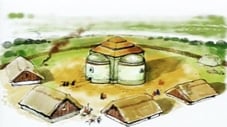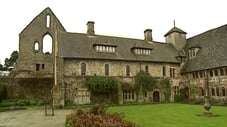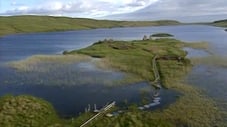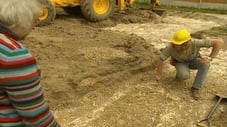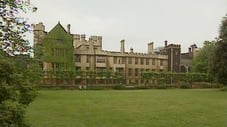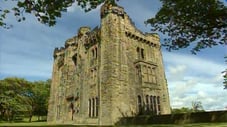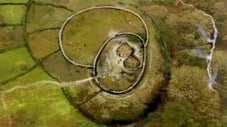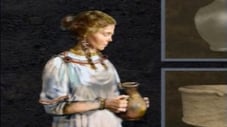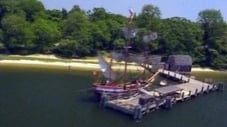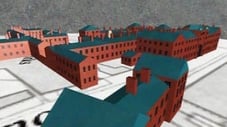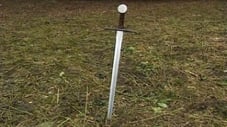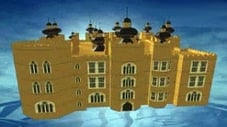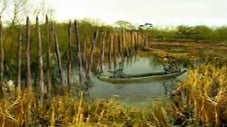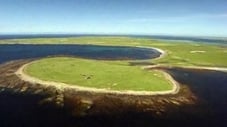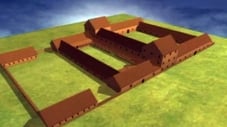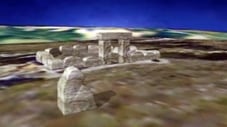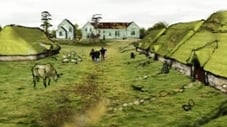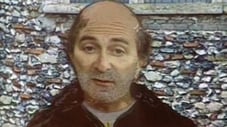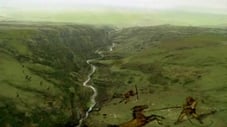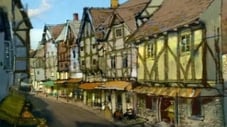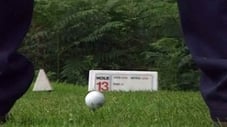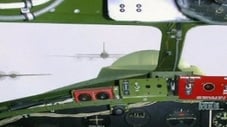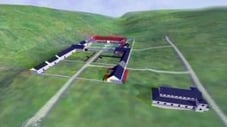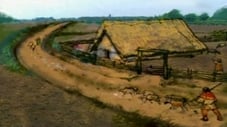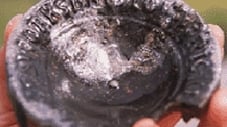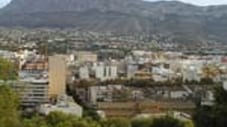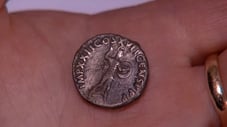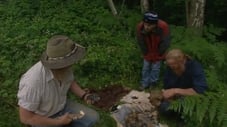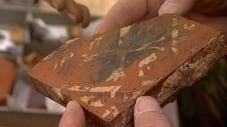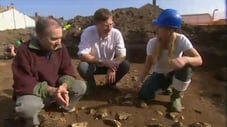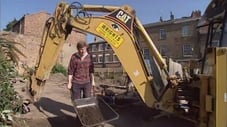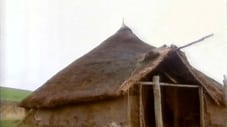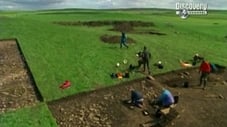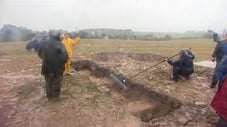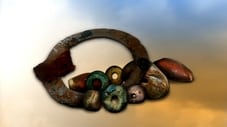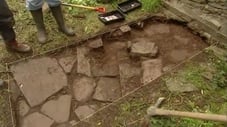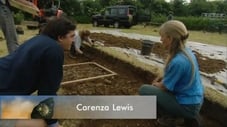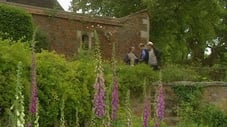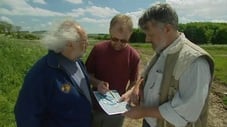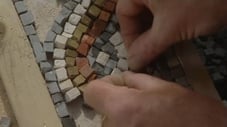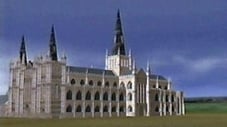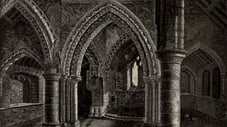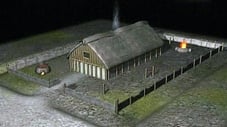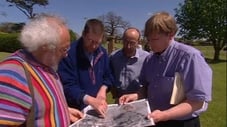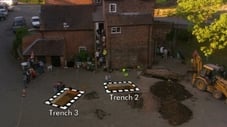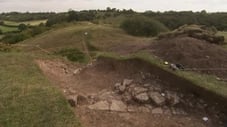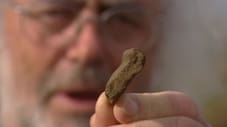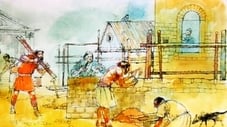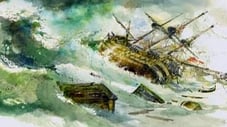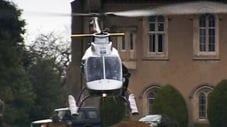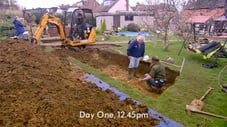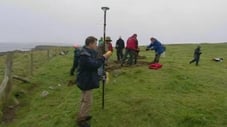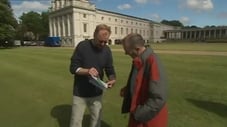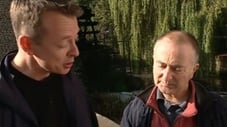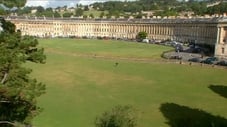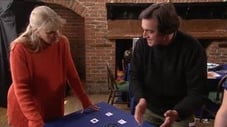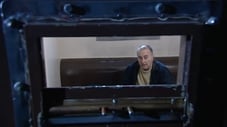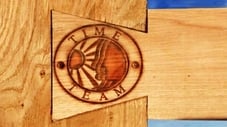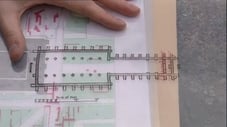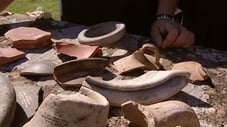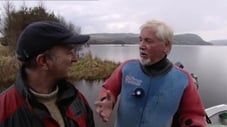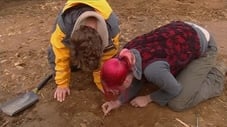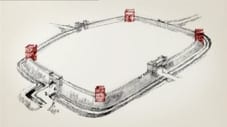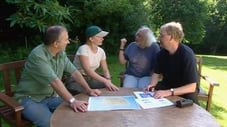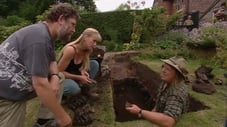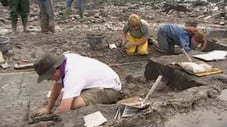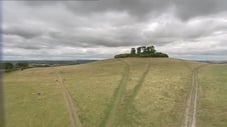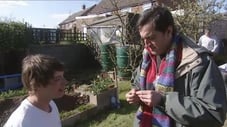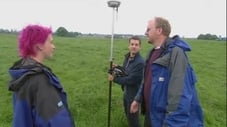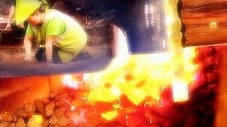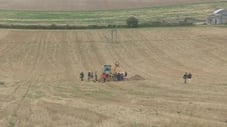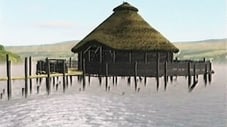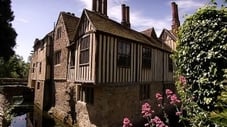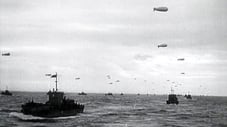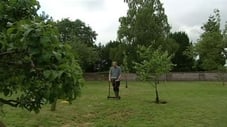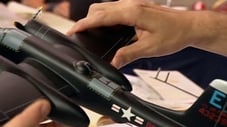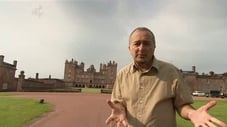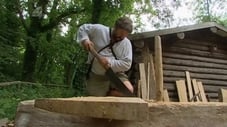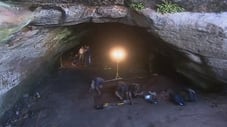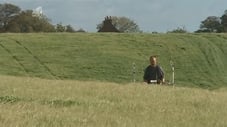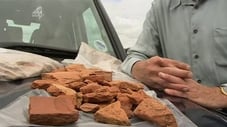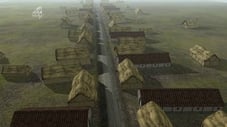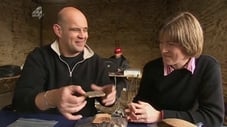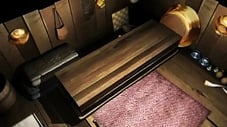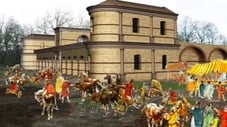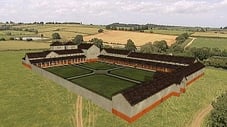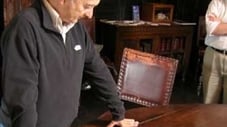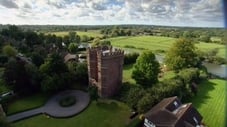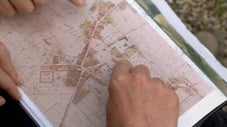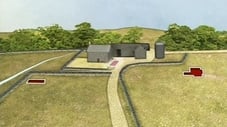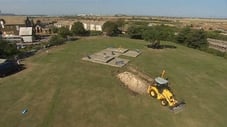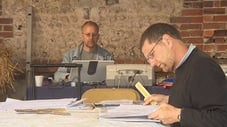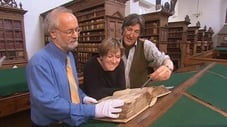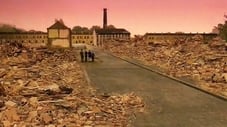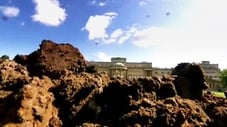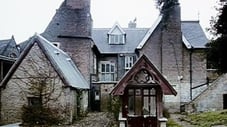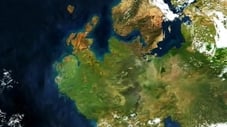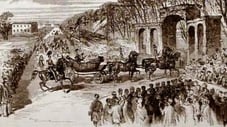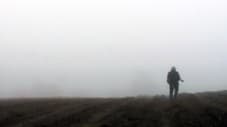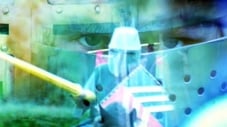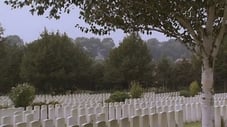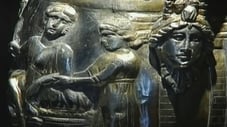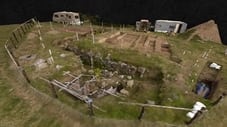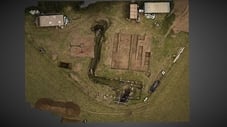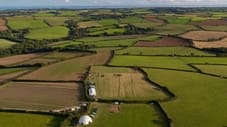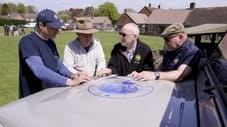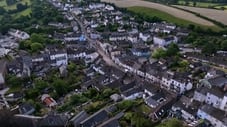
Time Team (1994)
← Back to main
Carenza Lewis as Self - Field Archaeologist
Episodes 148
The Guerrilla Base of the King - Athelney, Somerset
In this first ever episode of Time Team, Tony and the team travel to Athelney in Somerset to investigate a series of hills (once islands in a bog) that became Alfred The Great last defensive positions after a series of losses to invading Viking forces. It is also the place Alfred began the great rally that saw him re-conquer most Wessex and laid the foundations of the nation that was to become England.
Read MoreOn the Edge of an Empire - Ribchester, Lancashire
Ribchester in Lancashire has been known for some time as a site of a Roman fort. The Time Team arrive in the town to answer two questions, one is to consolidate all the previous excavations on the site, and the second to define the outline of a possible older wooden fort that is thought to have been in the area.
Read MoreThe New Town of a Norman Prince - Much Wenlock, Shropshire
The Time Team go to the small town of Much Wenlock, after they receive a letter from a resident explains a recent excavation uncovered possibly the oldest house in the town. What they discover is the remains of an old Saxon village transitioning into a larger newer Norman settlement.
Read MoreThe Fortress in the Lake - Llangorse Lake, Powys
The Time Team travel to Brecon Beacons in Wales, they have come to investigate a small man-made island in Llangorse Lake. Locals tell many strange legends including hearing the sounds of Church bells echoing across the body of water at night. The Team want to know who built the island and try to find evidence to support the stories of it eventual fall into disuse.
Read MoreLord of the Isles - Finlaggan, Islay
The Time Team travel to a group of islands on the western side of Scotland to investigate a culture known as the "Lords of the Isls" - who ruled the islands 1000 years ago. The team joins a group from the Scottish National University who've been working in the area for some five years uncovering the history of these people. What the Time Team discovers throws the whole excavation into a new light and suggests people may have lived in the area thousands of years prior.
Read MoreThe Saxon Graves - Winterbourne Gunner, Wiltshire
The Time Team visit Hylton Castle near Sunderland. A local group want to redevelop the local area as a tourist attraction but don't want to disturb any hidden structures.
Read MoreThe Lost Villa - Tockenham, Wiltshire
Tockenham village, in the Wiltshire countryside. Despite the fact that there are no Roman remains in Tockenham, the village's 15th century church, St Giles, has a small pagan Roman statue embedded in one of its outer walls.
Read MoreThe Archbishop's Back Garden - Lambeth Palace, London
The Time Team traveled to Lambet Palace in the heart of London. They are trying to unravel the enigma of why the Romans crossed the Thames in a different area to where they developed the city. The team needs to employ some extreme archeology to try an understand what the Romans where thinking.
Read MoreMedieval Dining Hall - Hylton Castle, Sunderland
The Time Team travel to Winterbourne Gunner in Wiltshire to investigate a housing development that has come to a halt because of an alarming number of Saxon graves found in the area They successfully work their way through the maze of finds but in doing so discover what seems to be a whole new layer of history in the town.
Read MorePrehistoric Fogou - Boleigh and Treveneague, Cornwall
Recorded between 17 and 19 March 1995, the team try to discover what a 2000-year-old underground chamber (fogou) beneath Jo May's garden was used for. Dowser Hamish Miller shows the extent of the fogou beneath the lawn, and Tony tries his hand at dowsing. But Mick is skeptical, preferring to rely on the geophysical survey. They are also trying to find the Iron Age settlement that would have adjoined the fogou. Joining the team are archaeological geophysicist Susan Ovenden, and county archaeologist Nick Johnson. The programme includes an experiment in extracting pure tin from the local stream.
Read MoreHunting for Mammoth - Stanton Harcourt, Oxfordshire
Recorded between 21 and 23 April 1995, in this episode the team go to a gravel pit that is soon to become landfill, where they attempt to unearth 200,000-year-old remains of mammoths and other prehistoric animals. Gravel pits are typical sites for paleolithic remains. But the chances of finding evidence of any prehistoric peoples are remote. Joining the team are Christine Buckingham, Kate Scott, and palaeontologist Russell Coope. Wood anatomist Rowena Gale tries to match ancient and modern wood samples For this episode the team are joined by archaeologist Kate Scott and geologist Christine Buckingham.
Read MoreVillage of the Templars - Templecombe, Somerset
Recorded between 26 and 28 May 1995. A 13th century picture of Christ, strikingly similar to that on the Turin Shroud, has turned up. It's believed to belong to the Knights Templar, a medieval order of monks who gave their name to the village of Templecombe. The team investigate a manor house thought to be on the site of a monastery. What's left of the monastery, and who were the Templars anyway? So far all the evidence seems to be outside the house, where Phil and the team have already dug up pieces of encaustic tile. Carenza and Robin are doing some research among the documents.
Read MoreA Wreck of the Spanish Armada - Teignmouth, Devon
Recorded between 30 June and 2 July 1995. 20 years ago a teenage boy discovered a 400-year-old bronze cannon in water close to the south Devon coast. Nobody has yet identified the ship it belonged to. Will there be enough left of the wreck to identify it? As usual, Time Team have only three days to find out. Tony is looking forward to getting into his diving suit. But the team cannot dive until the wreck's archaeological supervisor, Chris Preece, arrives. Meanwhile the wreck's finder, Simon Burton, tells his story. Undeterred by disappointing geophysics results, the divers go ahead with their search in murky water. On land, armoury expert Nicholas Hall demonstrates the cannon. Ultimately Robin comes up with a theory about the ship's origin and purpose.
Read MorePalace of the Irish Kings - Emain Macha (aka Navan Fort), County Armagh
Recorded between 7 and 9 April 1995, the team are at Emain Macha (aka Navan Fort), County Armagh, where according to Celtic legends three palaces were built. The evidence of two have been found and the team try to find evidence of the third.
Read MoreTreasures of the Roman Field - Lavenham, Suffolk
Recorded between 28 and 30 August 1995. The team arrive in a large square field about 20 miles from Colchester. This is an area typically rich in Roman activity. Several remains have previously been dug up, including coins, an elaborate key, and Samian ware. Adrian Thorpe, the farmer, wants to know more. The indications are of a settlement with high status buildings, maybe timber-framed. With recycled fragments of genuine Roman glass, fired up in a homemade furnace, glassblower Ed Iglehart creates an authentic conical beaker. Among hundreds of finds is a metal owl brooch. They are joined by Jude Plouviez from Suffolk County Council, Roman specialist Lindsay Allason-Jones, environmental archaeologist Peter Murphy, and coin specialist Daphne Briggs.
Read MoreMaryland, USA - St. Mary's City, Maryland, USA
Recorded between 17 and 19 May 1996, the team go to St. Mary's City in Maryland to work with American archaeologists to look for evidence of the city founded by English colonists in 1634. Different archaeological styles between American and British addressed, with the Time Team conducting geophys onsite for the first time. Finds: two buildings, including fort.
Read MoreMystery of the Cornish Skeletons - Launceston, Cornwall
Filmed between 22 and 24 March 1996. A local landowner has discovered human bones while installing water pipes. It is known to be the site of a former leper hospital, and a major crossing between Devon and Cornwall. How much more can Time Team discover about it? Phil uncovers a complete skeleton which has received a Christian burial, and which Osteoarchaeologist Margaret Cox identifies as a young adult female. She also examines the bone fragments for signs of leprosy. Juliet Griffin makes a herbal poultice to dress the lepers' wounds. Robin Bush looks at the 13th century charter granted to the hospital.
Read MoreSteam-Powered Mint - Soho, Birmingham
Recorded between 5 and 7 April 1996, this episode sees the team try to discover what remains of Matthew Boulton's Soho Manufactory, an important factory and home to the world's first steam-powered mint, during the Industrial Revolution. They are joined by industrial archaeologist George Demidowicz.
Read More8th Century Church - Govan, Glasgow
Filmed from 14 to 16 June 1996, in this episode the team try to find out why the graveyard of a 19th century church features large tortoise-shaped gravestones dating back to the Dark Ages. The team are joined by Scottish prehistorian Anna Ritchie and archaeologist Steve Driscoll.
Read MoreNorman and Medieval Castles - Malton, North Yorkshire
Recorded between 5 and 7 July 1996, the team try to discover a medieval castle and a Jacobean mansion. Barry Scott (bladesmith) makes a sword using traditional techniques, and the Conquest Society demonstrates hand-to-hand combat with authentic armour and chainmail.
Read MoreRoman Villa - Netheravon, Wiltshire
Filmed from 2 to 4 August 1996, this episode looks for a Roman villa that was first partially discovered 90 years before by William Hawley. Part of the site - a former army barracks - is covered in concrete, which at least protects what is underneath. But as they don't know exactly where the villa is, it could be a problem for both the diggers and the geophysics team. The team are joined by Duncan Coe (county archaeologist), Mark Corney (Roman buildings expert) and Lindsay Allason Jones (Roman finds). At the end of day two Lindsay supervises an al fresco Roman-style meal. By day three they have the bare outline of a very substantial, high-status building complete with mosaic floors and central heating. But then unfortunately the time runs out.
Read MoreChristmas Special – Much Wenlock - Much Wenlock, Shropshire
As a curtain-raiser for the 1998 series of Time Team, which started in January 1998, Tony and the team gathered. The first Time Team special to air took a look back over the last five years. Over the years, viewers have flooded the series with queries as to what happened after Time Team finished their three-day investigations – were the sites further excavated, were finds available to see in museums and how did local people react to finding an important archaeological find on their doorstep?
Time Team returns to a few key sites for updated reports and the Team members also remember their favourite moments and finds.
Read MoreRichmond Palace - Richmond, Surrey
Filmed between 25 and 27 July 1997. The team are camped on an immaculate suburban lawn next to the Thames. They are searching for the now vanished Richmond Palace, site of the death of Elizabeth I. But amazingly nobody is exactly sure of its whereabouts. The first task is to dig up the lawn under the supervision of landscape gardener Martin Whitaker. Immediately they find evidence of a substantial high status Tudor building. They are joined by palaces expert Simon Thurley and local historian John Cloake. Tudor expert Hazel Forsyth shows Carenza how to make a pomander. Plants from the garden are used by Maria Lis-Balchin to brew up some Elizabethan perfume. The property owner was The Baron van Dedem.
Read MoreBronze-Age Trackway - Greylake, Somerset
The team go to the Somerset levels in search of a 4,000-year-old wooden trackway. The quickest way to get across the marshes that used to exist here in the Bronze and Iron Ages was across wooden walkways. Now the team hope to find evidence of these footbridges.
Read MoreViking Graves - Orkney, Scotland
The team go in search of evidence of the invasion of the Vikings, and its influence on ancient Britain. The team travel to the Orcadian island of Sanday to try to find out whether four mysterious mounds there are evidence of a Viking settlement or even a Viking burial site.
Read MoreRoman Villa - Turkdean, Gloucestershire
3 days of live excavation. The weekend ended with evidence of a Romano-British villa complex that is one of the largest ever found in Britain. This programme is an edited version of that weekend. They discover that the villa dates from the very first days of the Roman occupation. Amongst their new finds is an entire, untouched Roman water course.
Read MoreCopper-Age Settlement - Mallorca, Spain
Time Team goes abroad to tackle one of its most challenging sites. They search for evidence of one of the most enigmatic cultures in the world on the Spanish island of Mallorca. The Beaker people flourished in Europe around 4,000 BC, but there is very little evidence of their civilisation, which is thought to have made the first use of metal.
Read MoreAston Eyre Farmhouse - Aston Eyre, Shropshire
Filmed between 27 and 29 June 1997, the team go to Shropshire and search for a complex of medieval buildings in Aston Eyre, where the only remaining building is a farmhouse that used to be a gatehouse. They are joined by archaeologist Mark Horton and archivist Paul Stamper. Tree rings expert Dan Miles tries to get some dates from beams in the gatehouse. Ian Pritchett demonstrates a traditional lime kiln. Finds: potential earlier structure found at end of day three, but time ran out before they could determine what it was.
Read MoreCathedral Hill - Downpatrick, County Down
Recorded between 19 and 21 February 1997, the team look for the early monastic buildings on Cathedral Hill, where according to legend St. Patrick built a monastery and was buried. They are also digging up medieval finds, including roof tiles and glass, which indicate a high status building. They soon identify the large double ditch which originally enclosed the monastery complex. Victor tries his hand at medieval calligraphy and helps create an illuminated manuscript with a portrait of a familiar face, complete with hat and feather. We also see some vellum making.
Read MoreDeserted Medieval Village - High Worsall, North Yorkshire
Filmed between 10 and 12 October 1997, Time Team go to High Worsall, near Middlesbrough, a village that almost completely disappeared hundreds of years ago. Finds: 14th century buildings and manor house, pristine spindle whorl. Experimental demonstration: fishing and cooking caught fish. Also, historians Robin Bush and Dawn Hadley are followed while they research the village and create a timeline.
Read MoreWedgwood's First Factory - Burslem, Stoke-On-Trent
The Team are in Burslem, Stoke-on-Trent, to investigate what remains of Josiah Wedgwood's first factory and to discover what pottery he was making there. They find evidence of several centuries of potting and bottle kilns, including a time capsule of the pottery of Enoch Wood & Sons. Experimental archaeology: a replica creamware vase.
Read MoreBack Garden Roman Finds - Papcastle, Cumbria
The team are in North West England, investigating Roman finds and a possible Roman building, unearthed in a family's back garden. The house is just 100 metres from a Roman fort, and south-west of the end of Hadrian's Wall. Geophysics are using state-of-the art Swedish radar equipment, to detect foundations beneath two metres of soil. A fragment of bronze mirror hints at a domestic settlement, a vicus, that would have sprung up next to the fort. But the diggers are finding plenty of archaeology, indicating much larger and more organised Roman building, possibly a city. Through the expertise of potter Gilbert Burroughes, the team are going to try to make a Samian ware bowl during the three days. The team are joined by Roman specialist Lindsay Allason-Jones.
Read MoreDominican Friary Church and Norman Cathedral - Thetford, Norfolk
Time Team have been invited by pupils of Thetford Grammar School in Norfolk, to investigate the remains of a Dominican friary church and a 1,000-year-old Norman cathedral, in their playground. There is much interest from the pupils when the team excavate human bones. Ecclesiastical historian Janet Burton describes the origins of the Dominican Order. Stonemason Simon Williams gives a practical demonstration of medieval wall-building using knapped flint and lime mortar. Stained glass expert David King confirms medieval dates for fragments from the friary. The junior school makes a timeline frieze, complete with felt bishops and monks. It all ends in an open evening for parents.
Read MoreCooper's Hole - Cheddar Gorge, Somerset
Investigation, at the invitation of the cave's owner, the Marquess of Bath, to see if there is evidence of Palaeolithic human activity in the cave. This may be among the oldest homes in England. The ultimate aim is to get the site scheduled and thus protected from unofficial damage. However it soon becomes clear there is a lot of preparatory work involved. They are joined by palaeontologist Andy Currant, and cave archaeologists Larry Barham and Kate Robson Brown. Caver Malcolm Cotter directs them to a cache of bones; but the tunnel is blocked by sediment from flooding.
Read MoreMedieval Plympton - Plympton, Devon
In the 12th century many towns were designed and laid out on regular lines. The people of Plympton believe there is enough evidence to plot the layout of the medieval town which surrounds the ruins of their castle, and which was formerly owned by the immensely powerful and wealthy de Redvers family. As usual, Time Team have three days to find it. Back gardens and interiors will provide the clues, rather than frontages which have probably been altered many times in the last 800 years. So they will need plenty of help from local householders. They are joined by Plymouth city archaeologist Keith Ray and dendrochronologist Robert Howard.
Read MoreTudor Dockyard - Smallhythe, Kent
Looking for evidence of a 15th century dock, the team are in Small Hythe. The dock was once next to the mile-wide River Rother but its location is now an overgrown field, ten miles from the sea. And early excavations reveal nothing more recent than wood from a prehistoric forest. Medieval ship expert Ian Friel explains that the dockyard used to have high naval significance, and was visited by Henry V. Woodworker Damian Goodburn uses authentic tools to build a ship's clinker hull. Victor draws the biggest ship ever built here, the Jesus. Using geophysics, John Gater and Sue Ovenden pinpoint the course of the old river. And very soon the finds start to accumulate, revealing the true scale of activity here.
Read MoreGolf Course Roman Bathhouse - Beauport Park, Sussex
Historian Guy de la Bedoyere asks the team to investigate the isolated ruins of a bath-house, discovered by Gerald Brodribb in the midst of dense Sussex woodland. Gerald has made a scale model of the building, and Guy explains the connection to the Roman navy. After a demonstration of dowsing from Gerald, the team's first task is to clear the land before digging. With ancient technology expert Jake Keen and blacksmith Reg Miles, Phil attempts to smelt iron using a traditional furnace. The team are also joined by archaeometallurgist Gerry McDonnell.
Read MoreBombers In Reedham Marshes - Reedham, Norfolk
Time Team team up with air crash investigators to discover what happened to two B-17 bombers which crashed with loss of all lives on board on 21 February 1944 into marshes near Reedham, Norfolk. The airplanes were returning from a bombing raid on a German target as part of the Big Week offensive. Parts of one airplane are recovered, and the Team speak to surviving crew members of a third plane that was in the formation. Experimental archaeology: A piece of nose art painted as a memorial to the bomber crews, painted by a former Red Cross volunteer who had painted some during WWII.
Read MoreBack To Turkdean - Turkdean, Gloucestershire
Time Team revisit a live dig from 1997, where they found a large Roman complex in a Gloucestershire field. But at the same time, geophysics recorded evidence of more buildings. And so the team have returned to investigate a greatly expanded area. Almost immediately Phil uncovers some impressive looking archaeology. They decide to build a Roman altar with a special inscription. They are rejoined by Roman specialists David Neal and Lindsay Allason-Jones.
Read MoreField Cropmarks - Kemerton, Worcestershire
An aerial survey of a Worcestershire field has revealed cropmarks leading to substantial Bronze Age finds. But Iron Age remains also exist. Time Team tries to sort it out. Local schoolchildren help with a bit of fieldwalking; and Mick shows how cropmarks and posthole marks become visible in fields. Francis Pryor explains the difference between Bronze Age and Iron Age and describes life in a roundhouse. Also joining the team are archaeologist Malcolm Atkin and environmentalist Liz Pearson; while wood specialist Guy Apter gets the kids to help make a Bronze Age ard (plough).
Read MoreRuined Norman Church - Bawsey, Norfolk
This live dig centres on a ruined Norman church on a hill in Norfolk. This National Trust site promises to be the richest source of finds that Time Team have yet seen, with previous evidence of human occupation from most periods in antiquity. This requires several trenches, including the longest one that Time Team have ever dug. They start with some fieldwalking and metal detectoring, before digging in earnest. Among many finds are a bronze age arrow head, a medieval tiled floor, coins and several well-preserved skeletons. One skull shows clear evidence of having been brutally slaughtered by a swordsman on horseback. The team are joined by Helen Geake, Neil Holbrook, Andrew Rogerson, pottery expert Paul Blinkhorn, osteoarchaeologist Margaret Cox, and historian John Blair. Celebrities Sandi Toksvig and Hugh Fearnley-Whittingstall also drop in. Hugh and Victor help Saxon re-enactor Russell Scott to recreate a bronze artefact from scratch.
Read MoreMontravers Estate (Part 1) - Nevis, West Indies
Invited by historian David Small, the team are on the tiny Caribbean island of Nevis, for a six-day dig to uncover the history of sugar production and slavery here. They are investigating a particular plantation, Montravers Estate, now overgrown, originally owned by wealthy 18th century Bristolean John Prater Pinney. Robin visits Bristol University, researching the extensive documentation. Back on Nevis, pottery expert David Barker is shown pottery sherds, most of which he dates to the 1840s. Phil crosses to neighbouring St. Kitts, to help make sugar from sugar cane. Sugar would have been extracted in a mill operated by teams of oxen. Molasses, the byproduct of sugar processing, was fermented to make rum. In the jungle Stewart searches for a slave village. They are also joined by local historian David Rollinson.
Read MoreMontravers Estate (Part 2) - Nevis, West Indies
Invited by historian David Small, the team are on the tiny Caribbean island of Nevis, for a six-day dig to uncover the history of sugar production and slavery here. They are investigating a particular plantation, Montravers Estate, now overgrown, originally owned by wealthy 18th century Bristolean John Prater Pinney. Robin visits Bristol University, researching the extensive documentation. Back on Nevis, pottery expert David Barker is shown pottery sherds, most of which he dates to the 1840s. Phil crosses to neighbouring St. Kitts, to help make sugar from sugar cane. Sugar would have been extracted in a mill operated by teams of oxen. Molasses, the byproduct of sugar processing, was fermented to make rum. In the jungle Stewart searches for a slave village. They are also joined by local historian David Rollinson.
Read MoreChristmas Special – Barley Hall - Barley Hall, York
This pre-Christmas special offers a taster of what is coming up in the next series – and provides an update on previous Time Team digs. Presented by Tony Robinson from York's Barley Hall, where a Medieval Christmas celebration is in full swing, the show tells what has happened at many of the digs featured in the last series.
Read MoreThe Mystery of Seahenge - Holme-Next-The-Sea, Norfolk
Last year, on this bleak and beautiful stretch of Norfolk coastline, a local man made an extraordinary discovery. Walking the beach at low tide he found a bronze axe head. Nearby, was a mysterious circle of eroded timber posts half buried in the sand, and in the middle of the circle was a huge upturned tree stump.
It’s utterly intriguing nothing quite like it’s ever been found before and everyone wants to know who built it, what it was for and what it originally looked like.
Read MoreA Muslim Port In Spain - Denia, Spain
1000 years ago, the port of Denia on the Costa Blanca used to be a thriving Islamic outpost in medieval Europe, before being Christianised in 1242. During this period Spain benefitted from a sophisticated Arab culture, including maths, astronomy and art. Members of Time Team are here to help with a major dig, before the site is redeveloped. They are particularly hoping for evidence of Islamic pottery and burials. Bone specialist Jackie looks at the many skeletons that have already been discovered. Phil has been invited to do a spot of scuba diving, all in the line of duty. Moroccan chef Mustapha Saaida tempts Carenza with some authentic spice-laden 900-year-old dishes, with ingredients from the local market. Mick "the Dig" is helping to uncover a kiln complete with pottery sherds. Victor sketches a complete landscape of the old town.
Read MoreThe Mosaic at the Bottom of the Garden - Cirencester, Gloucestershire
In 300 A.D. Corinium Dobunnorum was England's wealthiest city next to Londinium. Now it's the pleasant Gloucestershire town of Cirencester, and Time Team are visiting the leafy suburban Chester Street, where they hope the back gardens will yield clues about the bustling Roman city and its main highway, Ermine Street. Could a Roman temple have occupied this site - or even rarer, an early Christian church? They need to knock on a few doors to ask about digging up their plots. There is a bottle of champagne for anybody who can find a tessellated pavement. They are joined by Roman architectural historian Tom Blagg, coin expert Richard Reece and mosaic expert David Neal. The Ermine Street Guard offer Tony venison stew, and use a wooden crane to erect a stone column, fashioned by mason Giles MacDonald. In the public presentation, Stewart outlines a picture of the whole city, ably assisted by Victor's drawing. Among many Roman finds are coins, a brooch, a spoon and a bone die.
Read MoreOne of the First Spitfires Lost in France - Wierre-Effroy, France
On 23 May 1940 a Spitfire (P9373) flown by RAF pilot Paul Klipsch crashed into a field in Wierre-Effroy, France. Time Team, in concert with WWII aircraft historians and air crash investigator Steve Moss, try to find out what happened. They are joined by Klipsch's stepbrother, who last visited France on D-Day. Several residents of the village remember seeing the air battle and the crash, and Group Captain Allan Wright, who was flying in the same formation as Klipsch, comes along to help the investigation. The Spitfire wreckage is recovered, and investigation shows that Gunther Specht, flying a Messerschmitt Bf 110, shot down P9373. Experimental archaeology: Phil learns to repair a Spitfire wing flap with rudimentary tools.
Read MoreAn Iron-Age Roundhouse and a Henge - Waddon, Dorset
Time Team are doing a spot of gardening. Residents have presented them with evidence of historical activity, in the form of pottery shards and lumps and bumps in the landscape. While Victor sketches out possible buildings, Stewart tries to make sense of the trackways and earthworks in this spectacular landscape overlooking Portland Bill. Could there be a 4,000-year-old henge here? Back in Phil's trench in the garden, the first clear signs of a roundhouse emerge. Carenza helps potter Jim Newbolt to make and fire a collection of replica Iron Age and medieval pots.
Read MoreHadrian's Wall - Birdoswald, Cumbria
The team carry out the first-ever excavation of a cemetery at a Roman fort. This one is a World Heritage Site on Hadrian's Wall, delineating Roman Britain's northern boundary. Dead soldiers would have been cremated, and Jackie makes an experimental funeral pyre with cuts of meat. Unfortunately a downpour extinguishes the flames; but a second attempt succeeds. Stewart is more interested in the erosion of the land, which may have been caused by flooding or an earthquake. After some frustrating dead ends, they eventually piece together a plausible description of the site, recovering some interesting finds before time runs out on the third day. They are joined by site director Tony Wilmott and Roman finds expert Lindsay Allason-Jones.
Read MoreIn Search of the Earliest Traces of Mankind - Elveden, Suffolk
Beneath a modern holiday village in Suffolk lies evidence of early Stone Age activity, 400,000 years ago. Human remains from this period in England are exceedingly rare, but the team hope to find animal and plant debris. They will have to dig deep. They are joined by palaeontologists Simon Parfitt and Andy Currant from the Natural History Museum. Andy explains the importance of voles in dating such early material.
Read MoreThe Missing Cathedral and the Diabetic Prior - Coventry, West Midlands
Coventry's modern cathedral replaced the old cathedral, bombed to destruction by the Luftwaffe in World War II. A 3rd cathedral, St. Mary's, was also a Benedictine priory, demolished in the 16th century by Henry VIII. The building's destruction is explained. Tony gets a guided tour of Coventry's sister cathedral at Lichfield, by historian Richard Morris. Glass technician Colin Telford creates a stained glass panel. Meanwhile beautiful patterned floor tiles start to emerge, along with rose- and grape-shaped ceiling bosses. Phil uncovers a huge pier which would support the entire roof, though the spire would be wood rather than stone. And at the very end of day 3, they uncover a stone-lined tomb, which has to be completely excavated; so uniquely the dig extends into a 4th day. They are joined by osteoarchaeologist Margaret Cox.
Read MoreThe Royalists' Last Stand - Basing House, Hampshire
Basing House in Hampshire, owned by the Paulet family was once one of the largest private homes in Britain until besieged and destroyed in the English Civil War. Most of the ruins are a Protected Ancient Monument, but Time Team is permitted to dig on the edge of where the Basingstoke Canal once cut through the ruins, and they find evidence of the final assault in 1645. Meanwhile, in a field across the road, it appears that Charles Paulet built a hunting lodge around 1690, but the field is the site of centuries of building and tearing down, and the archaeology is so confusing three days are not enough to work everything out. The English Civil War Society come to re-enact the siege of Basing House, setting up camp in the Great Barn where the original besiegers camped. They show how musket and pistol balls were cast.
Read MoreA Bronze-Age Barrow and Walkway - Flag Fenn, Cambridgeshire
The team have their work cut out in the Cambridgeshire fenland, looking for remnants of an ancient culture in the flat landscape. The long wooden track would function as a barrier, defence and ritual passage where votive offerings were placed in the water. At the end of it they hope to find a barrow - a circular Bronze Age burial mound. Dave Chapman constructs a bronze axe in a primitive furnace; while wood expert Maisie Taylor looks for a suitable handle in nearby woodland.
Read MoreIn Search of the Palace of King Offa - Sutton, Hereford
Time Team are in Freen's Court on the English-Welsh border. A recent aerial photograph shows parch marks. The kingdom of Mercia was ruled by the ruthless eighth century King Offa. Could this be his palace? All sorts of colourful legends are associated with the site. But they are having trouble locating the parch marks on the ground. As it's a protected monument, they must dig by hand under the watchful eye of English Heritage inspector Paul Stamper. There are some medieval remains but so far nothing Anglo-Saxon. They are joined by historian John Blair, County Archaeologist Keith Ray, and pottery expert Alan Vince. Phil helps experts Richard Darrer and Guy Apter to make a replica wooden cement mixer.
Read MoreA Roman Temple in Sight of the Millennium Dome - Greenwich Park, London
The team dig for Roman remains in Greenwich Park, London. They are joined by Hedley Swain from the Museum of London, Harvey Sheldon from the University of London and Mark Hassel from University College, London. Chris Owen (reconstructor) demonstrates Roman plastering techniques and ingredients, and paints a fresco with Victor. A remarkable find creates much excitement, boosting their hopes of identifying a Roman temple. Stewart suggests that Watling Street may have run through the park. For results and reconstruction see https://www.royalparks.org.uk/parks/greenwich-park/things-to-see-and-do/ancient-greenwich/roman-remains
Read MoreNuns in Northumbria - Hartlepool, County Durham
In 1833 builders in Hartlepool, Northumbria found name stones and skeletons in what once was the graveyard of Hartlepool Abbey. Time Team investigates what remains of the monastery led by St Hilda in the front gardens and traffic islands of the modern town. They find the remains of a substantial Saxon building, the remains of a high-status medieval building, a book clasp dating from around the time of the monastery, and the complete skeleton of a woman who died sometime between 630 and 770, according to later carbon dating. They also bind a book with an elaborate leather cover, decorated with a silver medallion of a lamb copied from a mold found on the site earlier.
Read MoreYork
The dig's archaeological highs and lows are crammed into just 60 minutes in York where the finds range from a Roman skeleton complete with hobnailed boots, a Viking's discarded leather shoe, and the pillars of a monastic hospital. But what does all the evidence show? Who were these people and how did they live?
Read MoreThe Roman Fortress of Eboracum - York, Yorkshire
The team head to the ancient city of York for a special live dig. Finds include a Roman skeleton with hobnailed boots, and a Viking leather shoe. They are joined by Barney Sloane (site supervisor), Peter Addyman (director of the York Archaeological Trust), archaeologist Paul Thompson, osteoarchaeologist Margaret Cox, architectural historian Beryl Lott, finds expert Lindsay Allason-Jones, Denise Allen (glass specialist), Viking expert Patrick Ottaway and TV personality Sandi Toksvig. They build a brick kiln and make a Roman-style glass jug. Environmental archaeologist Andrew Jones sifts through organic debris to determine the diet of the inhabitants. Medical historian Carole Rawcliffe demonstrates some medieval herbal remedies.
Read MoreThe Real King Arthur - Tintagel Castle, Cornwall
This king was called Arthur, and his stories known to us all. But actually he’s shrouded in mystery, some people say that he was a chivalrous medieval king. Others, a gritty Dark Age warrior, others again, that he never existed at all. Time Team are setting out on a quest of our own to see if we can find out who he really was. It’s a journey back in time through centuries of myth and legend, on the way we’ll visit sacred lakes, pull our own sword from the stone and uncover the very first archaeological host.
Read MoreThe Time Team History Of Britain
Time Team takes a trip from the Palaeolithic to the present and plots the nation's past through the finds and revelations made across the last seven series. The Team pays a visit to classic UK archaeological sites, such as Grimes Graves and Bede's World, and examines key digs from programmes past to look at how archaeologists have interpreted the nation's history.
Read MoreThe Mystery of Mine Howe - Tankerness, Orkney
I’m in a remote farm in the Orkneys on a little hillock called Mine Howe. For years there have been stories around here of tunnels under the roads and mysterious underground rooms, which have never been satisfactorily explained until about six months ago when an extraordinary discovery was made. Acting on stories of a lost secret chamber first found in 1946, a local farmer and his friends set out to rediscover it. What they found was extraordinary. A set of stairs made of stone, disappearing into the earth and leading to a dark and secret chamber.
A set of stairs leading into a hillock’s unique. And now the whole archaeological world is agog, everyone wants to know who built it and when and what it was put there for.
Read MoreBehind The Scenes At Time Team
This special programme looked behind the scenes at some of the things that you don't usually see in the normal Time Team programmes.
Read MoreAn Anglo-Saxon Cemetery - Normanton, Lincolnshire
The team are intrigued that an Anglo-Saxon cemetery should contain Roman pottery. They are joined by archaeologist Naomi Field, Maggie Darling (Roman pottery expert), Martin Welch (Anglo-Saxon expert), Irit Narkis (archaeological conservator), and Kevin Leahy (Anglo-Saxon cemeteries expert).
Read MoreThe Man Who Bought a Castle - Alderton, Northamptonshire
Derek Batten bought a plot of land advertised as a castle and moat; but there is little sign of a castle other than a tree-covered mound surrounded by a huge ditch. So he has asked Time Team to sort it out. Because the site is a scheduled ancient monument, the team have to get permission from English Heritage for strictly limited excavations. To complicate matters further, Tony has to adjudicate on a long-running boundary dispute. The team is joined by castles expert Philip Dixon. Phil Harding gets kitted-out in chainmail as a Saxon footsoldier, facing a mounted Norman warrior on a Spanish stallion. The site is finally identified as a ringwork castle, built on a previous Saxon structure around the time of the Norman Conquest.
Read MoreThe Celtic Spring - Llygadwy, Powys
In deepest Wales lies an extraordinary site, with a Megalith, a Neolithic tomb, a Norman watchtower, early Christian symbols, and a natural spring. From this spring, the landowner has recovered an astonishing variety of coins, sculptures and jewelry. It is almost too good to be true, rather like an ancient theme park. So begins one of Time Team's most remarkable digs. Geophysics shows no structure anywhere on the site. The megalith is far too shallow to have stayed upright for thousands of years. And when the team unearth a sword, they start to get suspicious. They are joined by Celtic ritual expert Miranda Green, architectural historian Will Hughes, and Iron Age specialist Ian Stead. Results show that the site has been 'salted' and the finds have all been placed or build between the 19th century and as late as the 1980s. More info can be found at Llygadwy.
Read MoreA Waltham Villa - Waltham Field, Whittington, Gloucestershire
Time Team want to paint a picture of a family living in a Roman villa in the Cotswolds almost 2000 years ago. So they decide to dig a site near Fosse Way, only a few hundred metres from two previously excavated villas, in an area unusually dense with Roman remains. They are joined by Neil Holbrook, Roman specialist Richard Reece, and Finds specialist Alex Croom. Phil helps Peter Reynolds reconstruct a tribulum, a Roman threshing board. And the experts conclude that the villa was built very early after the Roman invasion, but abandoned – possibly for financial reasons – quite soon after.
Read MoreThe Lost Viaduct - Blaenavon, Torfaen
Time Team attempt to find what is reputed to be the first railway viaduct. Built in 1790, to move coal efficiently from the mine to the Blaenavon Ironworks, one mountain over, horses drew wagons along its tracks for only about 10 years. Spoil from local mines has not only covered the viaduct, but filled the valleys so completely that it is difficult to find any clues as to where to dig. Thousands of tons of earth are moved to find the top of the viaduct, 12 meters below the modern surface. It is too dangerous to enter, but a camera is lowered for a peek. Elsewhere on the site, the remains of a manager's house and workers' cottages are found. As experimental archaeology, a small blast furnace is set up within the disused ironworks, and a Time Team logo (wooden pattern carved by Victor Ambrus) and cart wheels are cast.
Read MoreA Palace Sold for Scrap - Rycote, Thame, Oxfordshire
The owners of Rycote House live in a lovely converted stable block, but they believe that the extremely grand house that once stood on the property and which hosted Tudor royalty burned down in 1745, and they want Time Team to investigate. In the trenches, no evidence of burning is found, but it seems that grand houses were built and rebuilt on the site from the 14th century through the Georgian era. Finds include a drainage tunnel dating from Capability Brown's landscaping work on the property. Historian Robin Bush returns from the Bodelian Library with an extraordinary catalogue from 1807, which details the sale of the grand house room by room. In nearby Thane, a townhouse contains a fireplace and doorways that possibly come from the sale. Food Historian Ivan Day cooks and serves sweetmeats and hippocras. Palace expert Simon Thurley joins the Team.
Read MoreAn Iron-Age Roundhouse - Salisbury Plain, Wiltshire
The team are on Salisbury Plain, over 38,000 hectares of land in South West England owned by the MOD. Though the whole area is rich in ancient remains, they are concentrating on Beeches Barn, an unprepossessing field rumoured to conceal an Iron Age roundhouse. Alongside the dig, they are helping Ian Apter to build one of the team's most ambitious projects, a full-size thatched roundhouse. Early geophysics results indicate not one, but several banjo enclosures. Such features are always accompanied by Roman buildings. The aim is to get the site listed as an ancient monument, but time is running out. They are joined by army volunteers, and Iron Age expert Peter Reynolds. The many finds include a 2,000-year-old bone comb, a quern-stone and a Roman coin.
Read MoreThe Bone Caves - Alveston, Gloucestershire
A pile of bones has been discovered in a narrow cave. They include cows, dogs and a human skull, which have been dated to the late Iron Age Celts. Local archaeologist Mark Horton is keen to discover whether this is a ritual site or just a rubbish pit; so Carenza joins a team of cavers to find out. Every handful of mud must be hauled out and sorted. Meanwhile bone experts Andy Currant and Margaret Cox examine the finds so far. One female skull shows clear evidence of a violent death; and another elderly female was suffering from Paget's disease. The quantity of dog bones may indicate an ancient dog cult, as described by Richard Massey from English Heritage. Archaeometallurgist Andrew Lacey casts a bronze dog model, designed by Victor. In spite of strong geophysics, the surface digs initially show no archaeology at all. Back in the lab, Margaret and Andy make a macabre discovery. Celtic expert Miranda Aldhouse-Green suspects this all hints at human sacrifice.
Read MoreThe Bone Caves - Alveston, Gloucestershire
The Battle of Bosworth was the decisive battle of the Wars of the Roses. It was the beginning of the end of three decades of treason, rebellion and dynastic warfare. Against huge odds, Henry Tudor won the day to take the English Crown. It was a turning point in English history, the end of the Middle Ages and the savage beginnings of the country we recognise today.
Read MoreThe Inter-City Villa - Basildon, Berkshire
While laying Brunel's Great Western Railway line 50 miles from London, navvies discovered mosaic floors indicating a Roman villa. The mosaics were broken up and the whole site ignored, until recent photographs of cropmarks showed the outline of the villa, among other features. Geophysics signals are also very strong. The trouble is, the diggers can find no structure beneath the surface. They are joined by Bernard Thomason from English Heritage, mosaics expert David Neal, Tim Allen of Oxford Archaeological Unit, and Jillian Greenaway from Reading Museum. Reconstructor Chris Owen supervises the recreation of a mosaic using thousands of tesserae.
Read MoreCoventry’s Lost Cathedral - Coventry, West Midlands
Welcome to what used to be the quiet backgarden of Coventry Cathedral's offices. Quiet that is, until Time Team kick-started an excavation into St Mary's, Coventry's first Cathedral which was ruthlessly destroyed by Henry the Eighth during the reformation. Over three days in 1999 we uncovered the remains of a building which would once have rivalled any Cathedral in England and yet work on this fantastic site had barely begun.
Read MoreHoly Island - Lindisfarne, Northumberland
The team look at a wide range of historical deposits on the iconic Holy Island of Lindisfarne, including evidence of military activity in the 16th and 17th centuries. They are joined by John Heward (architectural historian), archaeologists Caroline Hardie and Richard Fraser, and pottery expert Jenny Vaughan. Phil Harding helps cooper Jim Newlands to make a traditional timber cask.
Read MoreThe Leaning Tower of Bridgnorth - Bridgnorth, Shropshire
All that is left of Bridgnorth Castle is the 70-foot Norman tower. The team are in the park, trying to piece together what it looked like in its heyday, 900 years ago. They must dig outside the area of the scheduled monument. Phil and a group of enthusiasts recreate a 12th-century catapult known as a perrier. They are joined by castle specialist Philip Dixon, Mark Horton from Bristol University, Small Finds expert Lynne Bevan, and pupils from nearby Oldbury Wells School. Finally Philip is able to describe the construction and layout of the castle.
Read MoreThree Tales of Canterbury - Canterbury, Kent
In highlights from a previous live dig, the team visit the ancient city of Canterbury to investigate three separate sites, all connected by their religious functions. There is a Roman temple, a monastery, and a medieval site devoted to the construction of sacred buildings. Celebrity guests Liza Tarbuck and Sandi Toksvig are in attendance.
Read MoreThe Leper Hospital - Winchester, Hampshire
Outside of the city boundaries of Winchester, in what is today known as Hospital Field, once stood the St Mary Magdalen Leper Hospital. Probably founded in around 1140 by Henry of Blois, the superb chapel was recorded in engravings as a ruin in the 17th century. A large portion of the field was used as an army camp during WWI. A 180 metre well is discovered. Other trenches find the remains of the chapel, the Master's house, and the almshouses, as well as the cemetery, where a skull showing signs of leprosy is found. Within the chapel, an unusual double burial appears to be, as found in the records, the former Master of the hospital, followed almost 50 years later by his daughter. Victor sculpts a bust of a leper based on a skull excavated elsewhere. Nicholas Orme explains how lepers were viewed in the Middle Ages.
Read MoreThe Island of the Eels - Ely, Cambridgeshire
Time Team has been following an excavation in Ely, Cambridgeshire, for a feature-length documentary screened on 17 May. It has uncovered a remarkable picture of Ely in past centuries: channels where boats used to moor to load and unload goods; a medieval kiln with huge quantities of high-quality pottery finds; and a number of buildings fronting the road at Broad Street.
Read MoreDinosaur Hunters - Dinosaur Belt, Montana, USA
If you think archaeologists with their strange haircuts and their bizarre dress sense and their obsession with all the rubbish from ancient civilizations are a funny lot, you ain’t seen nothing yet. Phil and I are in Montana, in the wild west of the USA. And every summer, what seem like half the eccentrics in the universe turn up here to dig for even larger remains from times even longer ago. We’re here to meet the dinosaur hunters, we wanna find out what they do, and how they do it and hopefully even have a go ourselves.
Read MoreLondon's First Bridge - Vauxhall, London
At low tide on the foreshore of the Thames near Vauxhall Bridge in central London, a series of timber stumps is visible. How old are they, and what was their purpose? Time Team have the task of finding out, before the stumps are destroyed forever. They want to create a picture of the Bronze Age landscape here, 3,500 years ago. Post holes would indicate dry land building, while piles (pointed stakes driven into the ground) would indicate a structure above the river. To find out, they have to dig up one of the massive stumps. It's a race against time and tide to get it done in three days. Phil helps Damian Goodburn to make a simple piledriving rig with authentic tools. Stewart and Mick take a trip on the London Eye, to help them map the course of the ancient river. They are joined by Gustav Milne from University College London, and Jon Cotton from the Museum of London.
Read MoreThe Roman's Panic - Ancaster, Lincolnshire
Ancaster has yielded numerous Roman finds as well as a large cemetery with several sarcophagi from the period. In addition, the church is known in British archaeology for a Roman inscription dedicated to the deity Viridius. Phil finds the cemetery level, while Carenza discovers a layer filled with jumbled up human remains mixed with other bones. In the cemetery, Phil eventually uncovers the lid of a possible sarcophagus, and its excavation could thus require certain precautions due to the potential for lead poisoning and presence of biological hazards. However, the object proves to be a cist burial, as well as hazard-free. Incredibly, one of the cist slabs also turns out to contain yet another inscription to the god Viridius. In the end, the archaeologists suggest that the massive defences were ordered to be put up by the Roman central administration in Britain, and completely disrupted the original town layout.
Read MoreDiving for the Armada - Kinlochbervie, Sutherland
The team travel to West Scotland to investigate the wreck of a ship that may have been part of the Spanish armada. As this is a classic case of rescue archaeology, they are joined by the government's Archaeological Diving Unit, whose director Martin Dean explains why this exercise is so important. An ROV is operated from the surface. Historian Felipe Fernández-Armesto talks about the role played by the weather in the Spanish armada. Pottery specialist Duncan Brown looks at several remarkable finds, including some Maiolica ware. Both Phil and Tony do some diving. With the help of marine archaeologist Mark Lawrence, John uses a magnetometer to survey the seabed.
Read MoreThe Naughty Monastery - Chicksands, Bedfordshire
The team are invited to investigate the officers' mess of a military base in Bedfordshire, once home to monks and nuns of a 14th century Gilbertine Order. It was an experiment in unisex living. Jenni of Time Team volunteers to live like a nun during the dig, and is initiated by nunnery expert Roberta Gilchrist. John Ette from English Heritage monitors proceedings, and they are also joined by historian Richard K. Morris and osteoarchaeologist Margaret Cox. Robin Bush tells the miraculous tale of the Nun of Watton.
Read MoreThe Furnace in the Cellar - Ironbridge Gorge, Shropshire
The team head for a pub in Leighton, whose cellar contains the remains of a blast furnace once used for smelting iron. When Tony arrives, test pits are already being dug, and Geophysics are busy surveying the car park. They are joined by Paul Belford from Ironbrige Gorge Museum; and Jonathan Roberts shows Phil how to make a triangular charcoal clamp similar to those used in the 17th century. Mick visits the nearby Blists Hill Victorian Town, where Roger Fewtrell demonstrates making a 24 pound cannonball. They are also joined by researcher Colin Thom, industrial archaeologist Rob Kinchin-Smith, archaeometallurgist Gerry McDonnell, and finds expert Ceinwen Paynton.
Read MoreAn Ermine Street Pub - Cheshunt, Hertfordshire
It is 40 years since amateur archaeologists dug up Roman remains near Ermine Street, now hidden beneath Cheshunt Park. Time Team tell the story of the original excavation, using the detailed plan to conduct their own investigation. They believe the site's proximity to the road is the key to this dig. With some brilliant work by Stewart and John, they soon locate part of the road. Though frustratingly they cannot find any trace of it beneath the surface, they do find a brewery and possibly a pub. The brewing process is described by ancient technology expert Peter J. Reynolds. They conduct a mini-experiment comparing Roman surveying techniques with Henry's modern equipment. They are also joined by Roman experts Rosalind Niblett and Harvey Sheldon.
Read MoreIron-Age Market - Helford, Cornwall
Two massive hill forts on the Lizard Peninsula in Cornwall, at Gear and Caer Vallack, have never been excavated. In fact, no major Cornish Iron Age site has ever been investigated. Time Team have been given the tall order of making some sense of these two sites in three days. For many years, a local farmer has been collecting Stone Age and Iron Age artefacts. Already the geophysics results are showing a potential wealth of ancient human activity. But the sites are so huge that the team will have to be very selective. They are joined by Ian Morrison from English Heritage, ancient technology expert Peter J. Reynolds, pottery experts Carl Thorpe and Henrietta Quinnell. Re-enactor David Freeman demonstrates a sling-shot, a simple but effective weapon. Phil and Peter visit a reconstructed round house nearby.
Read MoreSiege House in Shropshire - High Ercall, Shropshire
The owners of a Tudor house, High Ercall Hall, want Time Team to investigate a bloody confrontation between the Roundheads and Cavaliers during the English Civil War, 350 years ago. In front of the house are four mysterious arches. Could they be relics of an older, medieval building, which apparently stood here for centuries before the present building? They are joined by buildings expert Richard K. Morriss, and Civil War specialist Glenn Foard.
Read MoreA Prehistoric Airfield - Throckmorton, Worcestershire
Hoping to uncover Bronze Age burials, the team descend on a disused airfield. But initial finds suggest the Iron Age, while geophysics shows plenty of circles and some larger rectangular enclosures. Jacqui Wood makes prehistoric cheese, and cooks a fish stew. Bronze Age enthusiast Francis Pryor gets excited about some faint track marks. They are joined by Malcolm Atkin and Robin Jackson from Worcestershire County Council, Ian George from English Heritage, and Iron Age expert Jeremy Taylor.
Read MoreA Lost Roman City - Castleford, Yorkshire
The medieval castle of Beaudesert in Henley-in-Arden suddenly vanished without trace, leaving a single stone on top of a mound. The people want to know what it looked like. "The Mount" as it's called by the locals, is a popular beauty spot and has suffered from erosion. Also, as it's a scheduled monument, there are limits to what digging can take place. The castle was built by the de Montforts in the early 12th century. Henry and Stewart create a simple 3D clay model of the building, which follows the natural contours of the hill. It looks as if the castle was demolished and the pieces sold off in the 15th century. Using authentic tools, bowyer Steve Ralphs makes a medieval longbow, which is tested against a crossbow of a similar period. Castles expert Sarah Speight describes daily life in the castle. Finds include a section of carved pestle and mortar.
Read MoreEvery Castle Needs a Lord - Beaudesert, Warwickshire
The medieval castle of Beaudesert in Henley-in-Arden suddenly vanished without trace, leaving a single stone on top of a mound. The people want to know what it looked like. "The Mount" as it's called by the locals, is a popular beauty spot and has suffered from erosion. Also, as it's a scheduled monument, there are limits to what digging can take place. The castle was built by the de Montforts in the early 12th century. Henry and Stewart create a simple 3D clay model of the building, which follows the natural contours of the hill. It looks as if the castle was demolished and the pieces sold off in the 15th century. Using authentic tools, bowyer Steve Ralphs makes a medieval longbow, which is tested against a crossbow of a similar period. Castles expert Sarah Speight describes daily life in the castle. Finds include a section of carved pestle and mortar.
Read MoreSteptoe Et Filius - Yaverland, Isle of Wight
Two years ago, local archaeologist Kevin Trott discovered Roman remains in a trench being dug for a water pipe. Unfortunately the trench had to be closed, and now Time Team are having trouble finding it. While Phil and the diggers look for the original trench, a full-scale field-walking exercise reveals many finds, both Roman and Iron Age; including a lot of bronze jewellery, seeming to show industrial activity. There are hints that enamelling was carried out here, so they decide to make their own enamelled hare brooch. Mick and Tony visit a nearby Roman villa with a detailed mosaic floor. On day three, Stewart spots some potential earthworks in a neighbouring field; so they decide to dig some exploratory trenches there. They end up with examples of activity from the Bronze Age, Iron Age, Roman occupation, and Anglo-Saxon period. To cap it all, at the end of day three they find a rare Iron Age burial. The team are joined for the first of many digs by Anglo-Saxon expert Helen Geake.
Read MoreSeven Buckets and a Buckle - Breamore, Hampshire
A Byzantine brass bucket was found during a 3-day live dig in a Saxon cemetery a year ago. Time Team returns to find out more about the people who lived and died here. Metal detectorists are called in to find non-ferrous metals, to complement Geophysics' magnetometer survey. They are joined by Anglo-Saxon specialist Andrew Reynolds, paleopathologist Alice Roberts and celebrity Sandi Toksvig. Sandi's ancestors were from Jutland, and Robin Bush argues that this whole area of Hampshire was actually occupied by Jutes before they were defeated by the Saxons under King Cadwalla in 686 AD. Ray Walton replicates a brass bucket, complete with inscriptions and silvering, from scratch. Osteoarchaeologist Margaret Cox tries to make sense of the burials including rare double burials – one of which uniquely has a child placed between two men. Finds include weapons and an exquisite enamelled belt buckle; and three more of the mysterious buckets, which all fit one inside the other.
Read MoreThe Big Dig in Canterbury - Canterbury, Kent
I’m right at the top of Canterbury cathedral and a few hundred feet below me, the most ambitious urban archaeological project the country’s ever known, has just begun. One eighth of the entire ancient city is gonna be excavated to make way for a huge new shopping centre. The Big Dig as its known locally is right down there in the centre of town. So it should be jam packed full of exciting archaeology from the present day, back to the Romans and maybe even beyond.
The Archaeologists are up against the clock though. The developers want them off site as quickly as possible. The Time Team are gonna be following the progress of the big dig both onsite and behind the scenes and were gonna be helping the local team to reconstruct the 2000 year story of this historic piece of Canterbury real estate.
Oh… And we’ve got just nine months to do it.
Read MoreLondinium, The Edge of an Empire - London
2000 years ago, London didn’t exist. It was created by the Romans in the first century AD. They settled just over there in what we now call the city. It started as a simple bridge over a river, but within a hundred years had become a bustling city with a population of 30,000. But it was a long way from Rome, and Londinium has always been considered a bit of a frontier town, an unsoffisticated outpost perched precariously on the very edge of the Roman empire, until now. Over the last nine months, archaeologists from the Museum of London have been working on a site right in the heart of the city, and what they’ve discovered, suggests that Londinium was in fact one of the most soffisticated and advanced cities in the whole Roman empire.
Read MoreThe Wreck of the Colossus - St Mary’s, Isles of Scilly
HMS Victory, probably the most famous English warship of all time. Everyone knows the story of how the Victory, under the command of Admiral Lord Nelson routed the French at the battle of Trafalgar and how Nelson died a national hero. Quite rightly, this is a perfectly preserved piece of our maritime heritage, but what happened to the other ships under Nelson’s command, where are they? Well, the simple answer is, they’re all long gone. Either destroyed in battle, lost at sea, broken up or just rotted away. Well, maybe not quite all. This is a story about the underwater excavation of one of Nelson’s lost ships. It involves Nelson’s mistress, Emma Hamilton; her husband, amateur archaeologist, Sir William Hamilton; a priceless collection of antiquities; a shipwreck and the discovery and raising of one of the most important pieces of maritime art ever found in British waters.
Read MoreTen Years of Time Team
Ten years ago university lecturer, Mick Aston was teaching archaeology to classes of just 30 students. Now, thanks to television, Mick, Tony and the team reach an audience of over 3 million.
Time Team, Channel 4's award winning archaeology show is ten years old.
Read MoreGarden Secrets - Raunds, Northamptonshire
Time Team investigates a back garden in Raunds, where a skeleton – aptly named Henry by his discoverer – has been found along with his Anglo-Saxon grave goods. The burial probably fits in with a number of other Saxon sites in the town and is seen in light of these. The team also look carefully at Henry himself, his attributes, anatomy and ailments, and have to tackle several logistical problems in association with excavating in such a constrained area as a garden. However, they also find the opportunity to extend the investigation across the fence to an allotment area behind the gardens. The experimental part of the program looks at various objects and medical remedies found in Anglo-Saxon society, presented by historical reenactors, while Victor recreates the appearance of Henry. In the end the archaeologists do confirm the presence of an Anglo-Saxon cemetery with various pieces of grave goods at the site, probably placed in relation to older Bronze Age burial mounds.
Read MoreMosaics, Mosaics, Mosaics - Dinnington, Somerset
Time Team travels to Somerset to investigate the discovery of an exquisite Roman mosaic in a field. The geophysical survey clearly indicates the presence of a substantial and well-preserved villa on the site. One of the main problems they tackle is the development of the building complex through time. By targeted examination of the structural remains, the archaeologists uncover evidence of several phases from a more humble early timber building to a two-story grand villa with two large ranges and a courtyard gate structure. In the end, the site turns out to contain one of the largest Roman villas in the UK.
Read MorePeak District Practices - Carsington, Derbyshire
Time Team examines a mysterious cave in Derbyshire where cavers have found several skeletons, some of them newborn babies and the earliest dated to the Stone Age. Finds from the cave have also provided dates from the Iron Age and the Roman period. The excavation proves potentially quite hazardous, as the chambers and tunnels are filled with precariously heaped stones which threaten to scree if the safety shoring moves or breaks, and some areas are considered just too unstable to work in at all. The archaeologists also investigate a nearby Bronze Age barrow, which previously has been subject to illicit excavation. In the cave they find more human and animal remains, although how these got there remains subject to some debate. The mound gets confirmed as a barrow and undisturbed secondary burials are discovered as part of the structure.
Read MoreThe Giant's Grave - Fetlar, Shetland
Time Team investigates a Shetland back garden for remains of Viking occupation after the discovery of a number of soapstone objects there. They also open a mound feature nearby called The Giant's Grave to see whether or not in fact it may be a Scandinavian boat burial. In the garden they find more soapstone objects, slabs with crossmarks, small souterrains, and wall lines, indicating the presence of a Viking Age farmstead. Phil tries to carve a soapstone lamp as the experimental part of the program. The mound turns indeed out to be a looted Scandinavian boat burial, as the team finds patterns of iron rivets showing the imprint of the vessel and a small piece of its keel – and by excavating carefully, the archaeologists also locate a Viking tortoise brooch not taken by the looters.
Read MoreJoust Dig It - Greenwich, London
Time Team investigates Placentia, the Greenwich palace of king Henry VIII. They try to locate his royal armoury and the tiltyard, where the court and nobility would have jousted and been entertained in mock castles. In the experimental part of the program, Tony looks at how Tudor armour would have been made and gets a breastplate of the period hammered and fitted. The armoury as a turns out to be too elusive for the archaeologists, but localized amounts of hammer scale, a residual product of forging, indicate its presence there. However, the tiltyard complex with its associated structures, like the banqueting hall, are firmly located.
Read MoreDigging Liberty - Merton, London
Tony Robinson and the team are hunting for Liberty's first factory in South London. 'Liberty silks' still evoke images of opulence and beauty, of floating dresses and more leisurely times. But their hunt proves far from leisurely.
Day three of the search brings the vital breakthrough – as well as an extraordinary attempt to recreate the 19th-century techniques of dying and printing those wonderful silks.
Read MoreDeath in a Crescent - Bath, Somerset
Time Team visit Bath to investigate parch marks seen in the park lawn of the Royal Crescent, indicating the presence of a large Roman road, possibly local remains of the Fosse Way. They also look behind the Crescent for Roman sarcophagi and wall lines found by builders of the now-gone St. Andrew's Church in the 1870s and noted by an antiquarian at the time. While the road ditches eventually yield Roman burials, the team does not locate any sarcophagi said to have been found there. Whether or not the large road, in fact, is the Fosse Way remains in the end uncertain, with arguments for both sides.
Read MoreBack to Our Roots - Athelney, Somerset
Time Team revisits Athelney Abbey, the hideaway of Alfred the Great, and also the very first site investigated by the team one hundred programs earlier. Ten years of technological advances in the meantime has significantly enhanced their geophysical survey methods and changes in heritage management attitudes have also given them the permission to dig at the site. Slag and magnetic readings suggest that iron and steel was smelted and worked at Athelney, the latter being a good indication of Anglo-Saxon presence. At the abbey site itself Phil and his diggers uncover several burials. Reenactors show Anglo-Saxon dress and weaponry and their Viking counterparts as the experimental part of the program, while Carenza and Tony make – and burn – traditional Saxon cakes. The archaeologists find a number of objects, a Medieval graveyard associated with Athelney abbey, a metalworking complex, and a substantial defensive ditch dug in the Iron Age, but reused in the time of king Alfred.
Read MoreLooking for the White House - Kew Gardens, London
Time Team visits Kew Gardens to find the White House, part of the second Kew Palace complex and favourite home of mad king George III. While Carenza is shown how decorated wine glasses of the period are made, Stewart induced a lot of confusion regarding the exact placement of the building due to inaccuracies in the original 18th-century map of the area. However, in the end, both the archaeology and the architectural plan match each other. The archaeologists also locate a tunnel for sheltered transport of meals from the kitchen block to the palace dining halls by combining geophysical survey with keyhole test pits.
Read MoreRescuing the Dead - Leven, Fife
A building development threatens a Bronze Age cemetery in Fife, and Time Team is there to carry out rescue excavations together with County Archaeologists. The graves are Cist burials in various states of preservation placed around a large boulder in a dug pit. The boulder is shown to cover another cist, and several of the burials contain in fact bones – not a certainty, given the acidity of the local soil – and grave goods. With skulls initially being found as the only form of human remains, the archaeologists wonder whether the site only contained skulls originally. The boulder cist is capped by a large stone slab covering a void beneath, and the logistics of lifting it prove a challenge. In the end, they uncover a chamber with skeletal remains, thus showing soil acidity to be the main culprit for the dearth of bones other than skulls in the other graves.
Read MoreNot a Blot on the Landscape - Castle Howard, Yorkshire
Time Team travels to Castle Howard to look for the lost village of Henderskelf, which was demolished around 1700 to make way for the new castle constructed on the estate and its formal gardens. But the exact placement of the village is uncertain. The geophysical survey is unable to help much so the team relies on a map from 1694 and visible lumps and bumps. Geophysics produces better results in their search for the lost village church of Henderskelf. Stewart advances their investigation significantly when he discovers a more detailed sketch of the village on the back of another old map from c. 1700 in the Castle Howard archives, but it scales poorly onto a modern map. When this is done, the team realizes that some of their trenches have missed target buildings altogether. Armed with all this evidence, the archaeologists finally get to grips with the elusive Henderskelf – which seems to have been utterly removed between 1700 and 1720 when the new castle was erected.
Read MoreA View to a Kiln - Sedgefield, County Durham
Roman finds from Sedgefield prompt Time Team to visit a field and subject it to investigation. Air photographs and geophysical survey show tantalizing signs of activity below the turf, while fieldwalking provides even more finds. However, these finds lead to some confusion, as the archaeology suggests a low-status site with farms or workshops, but the coin finds are of high quality and value. The coins are decided to originally have formed a hoard, presenting certain bureaucratic issues for the metal detectorists who brought Time Team to the site. The experimental part of the program investigates how Roman coins would have been mass produced. In the end, the archaeologists discover a well-preserved pottery kiln in a settlement complex they suspect represent a civilian industrial site supplying the Roman market in Britain – all of which Phil gets to show the local MP, Tony Blair.
Read MoreJailhouse Rocks - Appleby-in-Westmorland, Cumbria
The police in Appleby-in-Westmorland, Cumbria, know that their station dates back to the first gaol built on the site in the 1770s. They also know that two subsequent prisons, from the 1820s and the 1870s, also stood on the site. They invite Time Team to see what remains of the former prisons underneath their car park. Trench 1 finds the remains of the room where the 1870s prison's treadwheel was, trench 2 finds the remains of the 1770s cell block, which has its own story to tell. Trench 3 discovers the women's prison of the 1820s (previously prisoners were not segregated by sex), which had an underfloor heating system. One archaeologist volunteers to become a Victorian-era prisoner for 24 hours, put to hard labour breaking rocks, turning a crank handle to no purpose, and moving dirt from one pile to another. Finds include part of a warder's uniform and hobnail boots, and a bar from a prison window. Carenza acts as historian for this episode.
Read MoreHadrian's Well
A team of expert engineers, archaeologists and craftsmen are about to join forces in an epic archaeological experiment, to build a full size working replica of a Roman water lifting machine.
At almost 4 meters in height, capable of raising 7000 litres of water per hour, this was ancient cutting edge technology.
But no-one really knows how it worked or what it really looked like. What we do know is that the machine has to be installed and working in the Museum of London in three months time.
Read MoreBig Dig, The Hole Story - Canterbury, Kent
Digs at Great Easton, Leicestershire; Wolverhampton; Barnet; Oakamoor; Preston; Cheltenham; Upminster and Groundwell Ridge in Swindon.
Read MoreIn Search of the Brigittine Abbey - Syon House, London
The team are on the trail of a medieval mystery. Founded by Henry V and built by his son Henry VI, Syon Abbey was a large, wealthy monastery for nuns of an obscure Swedish order. During the reign of Henry VIII it vanished. Its remains lie beneath the lawns of modern Syon House, designed by Capability Brown. What they find is on a huge scale. But there is disagreement as to what kind of building it was. After investigating the foundations of the House, Stewart and Jonathan reach an agreement on the extent of the church. They are joined by buildings historian Jonathan Foyle and monastic expert Barney Sloane.
Read MoreA Roman Bath House and Edwardian Folly - Whitestaunton Manor, Somerset
Next to the beautifully manicured lawns of Whitestaunton Manor in the Blackdown Hills of Somerset lies a patch of muddy weeds. Coins and pottery have been found here, and it is supposedly the site of a Roman villa. But archaeology student Freya Bowles thinks differently. The team first have to remove weeds and tree roots without the use of mechanical diggers, as it's a scheduled monument. They are also extremely limited as to the size of the excavation. Clearly there are Roman remains, but mixed up with Victorian or Edwardian garden features. Gradually the plan of a Roman bath house emerges. The team are joined by mosaic specialist David Neal and buildings historian Jonathan Foyle. Directed by technological historian Robert Spain, they build a full-size replica hypocaust complete with under-floor heating.
Read MoreThe Crannog in the Loch - Loch Migdale, Scottish Highlands
There's an island-ish round area of stones in Loch Migdale - could it be a crannog? 200 meters away on the banks is a small (12 m diameter) circular feature - is it a henge? Time Team rounds up some experts on the prehistoric and finds out. They set up a suction dredge to investigate two areas of the loch feature, and find wonderfully preserved timber, proving that it's a built structure and thus a crannog. GPS surveying and a tip from a local farmer finds the causeway, now underwater, leading to it Trenches within the henge show that the entrance and wooden posts within it pointed towards notable features in the landscape. Stewart looks for the find site of the Migdale Hoard.
Read MoreSaxon Burials on the Ridge - South Carlton, Lincolnshire
The team investigate a possible fifth century cemetery in a ploughed field, where they find a metal shield boss. One male skeleton is holding a drinking vessel. There are hints of much earlier activity as well, including a Bronze Age barrow. Using authentic tools, they fashion a Saxon shield. Conservator Dana Goodburn-Brown examines the details in the x-rays of the shield boss; while Phil and members of Regia Anglorum demonstrate how the shields are used in battle. They are joined by bone specialists Alice Roberts and Margaret Cox, who unearth some coloured beads among the remains.
Read MoreThe Roman Fort That Wasn't There - Syndale, Kent
Nobody knows what happened immediately after the Romans arrived in 43 AD, because no Roman fort has been discovered in this part of South East England. Time Team are on a mission to find the missing link. Local archaeologist Paul Wilkinson believes he has already found a military ditch, which would surround such a fort. It's a prime site, right next to Watling Street. However geophysics cannot find any evidence for a ditch. So begins one of their most frustrating digs, directed by Neil Holbrook. Phil enlists in the Ermine Street Guard for a day. They are joined by Roman expert Tony Wilmott and pottery specialist Malcolm Lyne.
Read MoreAn Iron-Age Trading Centre - Green Island, Dorset
Green Island in Poole Harbour has already shown that it was a significant centre of Iron Age activity, with evidence of industrial activity and trading to and from the continental mainland. But it has never been properly excavated. Two huge jetties - now buried - indicate either a port or a defensive structure. The island is a SSSI (Site of Special Scientific Interest), which means hand-digging only, and replacing the topsoil. Very soon the finds start to multiply. Of particular interest is evidence of shale working for jewelry, and iron smithing. They are joined by Project Director Eileen Wilkes, archaeologist Miles Russell, Iron Age specialist John Collis, and metallurgist Roger Doonan. Experimental archaeologist Jake Keenan demonstrates shale working with primitive tools. Geomorphologist Vincent May explains that in prehistoric times the water level was two metres lower, and Green Island was much bigger.
Read MoreA Medieval Blast Furnace - The Old Furnace, Oakamoor, Staffordshire
The team are revisiting the garden of Furnace Cottage in Churnet Valley, where the previous excavation of an Elizabethan blast furnace produced evidence of much earlier iron-making. Stewart surveys the landscape, to piece together a picture of water flow and other features essential to iron smelting. But John is convinced that there is strong geophysical evidence for a furnace a mile away at Eastwall Farm. It could even be water-powered - a major discovery. They build a medieval style bloomery. They are joined by historian Pete Brown, and archaeologists David Cranstone, Bill Klemperer, Deb Ford, Gerry McDonnell, Tim Young.
Read MoreRescuing a Mesolithic Foreshore - Goldcliff, Newport
When the tide recedes at this point on the Severn estuary, rare evidence of stone age activity is uncovered. Time Team are on a three-day mission to help recover some of these relics before they are washed away. It involves excavating and painstakingly examining 15 cubic metres of muddy silt; but time is against them. The Mesolithic period is poorly understood, because these people were highly mobile hunter-gatherers who did not build permanent structures. They uncover some of the smallest artefacts they have ever handled. Phil and Brigid are fascinated by ancient footprints of adults and children, preserved in the sand. Phil excavates the massive tooth of an aurochs, an extinct giant prey animal. They are joined by Martin Bell of Reading University, Mesolithic specialists Nick Barton and Robin Crompton, and food expert Jacqui Wilson who cooks up a stone age feast.
Read MoreFertile Soils, Rich Archaeology - Wittenham Clumps, Oxfordshire
The British landscape is littered with Iron Age hill forts. A local archaeology unit is digging such a hill fort in Oxfordshire, but cannot afford to investigate a neighbouring larger hill, only 200 metres away. Both Roman and Iron Age remains have been found there in the past. But what is its relationship, if any, to the hill fort? The geophysics team identify a potential target, a square enclosure on the side of the hill. But before they can begin, they have to manually search the site for specimens of great crested newt, a rare protected species. At the beginning of day two, John's team find something which could be very special, a Roman church, apparently with a semicircular apse. They are joined by Tim Allen of Oxford Archaeology and osteoarchaeologist Angela Boyle.
Read MoreKing Cnut's Manor - Nassington, Northamptonshire
Digging up fields and car parks and back gardens is all very well, but how could Time Team pass up a chance to dig up a living room? The manor house in Nassington was purchased in a derelict state, and while restoring it, several massive post holes were investigated that are of a size and spacing to be a Saxon great hall. The pottery finds from the property suggest almost constant occupation from the Iron Age to the present, and the Ramsey Chronicle records that Cnut owned Nassington while king. Up comes the flooring so three trenches can be dug inside the house, while outside, various trenches are dug in the garden. It seems that hall after hall was built where the manor house still stands, but no trace can any longer be found of outbuildings which must have been there. Graeme Lawson visits with a selection of Dark Ages musical instruments, makes a reed pipe of elder wood, and plays out the episode with the Time Team theme music on pipe and lyre.
Read MoreBack-Garden Archaeology: Revisiting a Roman Villa - Ipswich, Suffolk
As renowned Suffolk archaeologist Basil Brown discovered, Castle Hill near Ipswich is named, not after a castle, but a substantial Roman villa. Brown was unable to complete his excavation, and Time Team have been called in by local schoolchildren to find out more. However, they will need to dig up a few back gardens to do so. Very soon it becomes clear that Brown's measurements were out of kilter. Halfway through day two, Phil makes a breakthrough. But not until 11 trenches are dug in 8 gardens does a full picture emerge. The team are joined by Roman specialist David Neale and site director Miles Russe
Read MoreThe Lost City of Roxburgh - Roxburgh, Scottish Borders
Time Team search for a Roman Villa complex on a 1950s housing estate in Ipswich. It should be easy as it was previously dug by an amateur archaeologist before the estate was built but his records and methods may not be all they seem.
Read MoreSheffield Steel City - Sheffield, South Yorkshire
The team followed ARCUS, the Archaeological Research and Consultancy at the University of Sheffield, on some of its excavations into Sheffield's industrial past. Early death, deadly machinery and the worst man-made disaster in British history were revealed as Time Team documented the work of the archaeologists who have spent more than six years digging through the remains of a city that was once the biggest producer of steel in the world.
Read MoreBrimming with Remains - Cranborne Chase, Dorset
Pigs rooting in a windswept field in Dorset unearthed fragments including Roman mosaic floor tiles. In addition, a Bournemouth University excavation team located some burials nearby. The farmer, Simon Meaden, has asked Time Team to investigate further. John's geophysics survey reveals a lot of activity. Very soon multiple finds start appearing, and to Tony's delight he is allowed to dig up a little beaker. Archaeologist Mike Parker Pearson produces a timeline of prehistoric and historic burial practices. Phil's trench is invaded by chickens. Gradually a complex picture emerges of human activity here over thousands of years, including a heated Roman villa with bath-house.
Read MoreThe Crannog in the Loch - Loch Tay, Perthshire, Scotland
Loch Tay, and the kind of view that draws people to Scotland. But the landscape isn’t the main attraction for archaeologists Nick Dixon and Barrie Andrian, who are much more interested in what they can see in the shallow waters around the edge of this loch. In this time team special documentary, you’ll be submerged into the world of underwater archaeology, and visit an Iron Age house that hasn’t been seen since prehistoric times. Are you ready? Stand by to dive into the Iron Age.
Read MoreThe Ten Million Pound House - Ightham Mote, Kent
Hidden away in Kent is an architectural gem.
A house that has some how survived with a little bit of every fashion imposed on it over seven centuries. This is Ightham Mote near Sevenoaks, bits of it date back to 1320 and officially it’s the most complete moated medieval manor house in the UK. At least it was until the National Trust started it’s most ambitious and expensive restoration project to date.
Since 1989 this building has been literally taken apart brick by brick and beam by beam revealing the hidden history of the house for the first time.
In this special Time Team documentary you will discover along with me that this is a totally different kind of archaeology. You’ll learn something about the twenty generations who lived here and see some of the things they deliberately hid away.
Read MoreD-Day - Normandy
60 years ago on D-Day, the allies invaded Nazi occupied France. The invasion force made up of a 150,000 US, British and Canadian troops, was the largest in the history of western civilization. The Americans were to land on Omaha and Utah beaches, Canadians on Juno and the British on Sword and Gold. Almost half of the total troops were British and among them were the 400 infantrymen of the first Dorset regiment. They landed here on Gold beach on the 6th of June 1944, and this is the story of their day.
Read MoreThe Manor That's Back to Front - Chenies Manor House, Buckinghamshire
Tony Robinson and the team visit Chenies Manor which is believed to have been upgraded in time for Henry VIII's visit around 1530. However, while a late 16th-century inventory suggests that an additional range of rooms fit for a king once existed, traces of them have vanished since the house fell into disrepair. Can the experts uncover the layout of the building as it appeared in Tudor times?
Read MoreThe Monastery and the Mansion - Nether Poppleton, Yorkshire
The villagers of Nether Poppleton, near York, join Tony Robinson and the team for some extensive digging as they try to determine the exact age of their village. The current layout follows a typical medieval pattern but a reference to the village in the Domesday Book has the experts thinking that it could date back to Saxon times at least.
Read MoreThe Bombers in the Marsh - Warton near Preston, Lancashire
On 29 November 1944, two US Douglas A-26 Invader bombers crashed in Warton Marsh. Both planes, along with a number of others, had left Warton Airbase in formation, en route to join forces in the preparations for the Battle of the Bulge. Only one minute off the runway and 1,000 feet into the air, the aircraft collided and came to rest in the marsh. All the crew died. Their bodies were recovered from the planes, but an investigation into the causes of the crash was inconclusive.
For this programme, Time Team enlisted a veteran air crash investigator, along with the RAF's 'crash and smash' team and other experts to try to find out what caused the crash. Each of the planes, including the engines, was believed to be relatively intact and, it was hoped, would provide the necessary information to determine why these two planes collided.
Read MoreFighting On The Frontier - Drumlanrig, Dumfries and Galloway
Twenty years ago, during a particularly dry summer, parch marks revealed what seemed to be a huge Roman fort a few hundred metres from the Duke of Buccleuch's extraordinarily grand house, Drumlanrig Castle, in Dumfries. The discovery lay untouched until Time Team took on the challenge to investigate it further.
The Team sought to answer a number of questions. Was it actually a Roman fort? If so, it was one of the most northerly ever found and therefore of special importance to Scotland's history. So when were the Romans there? No finds made previously had given any hint of the date of the structure.
Time Team also wanted to identify the roads leading in and out of the fort. Was there any kind of civilian settlement or other features nearby? And could the Team work out how the Romans made their famous draco, the military standard that made a sound said to have struck fear into the hearts of their enemies?
Read MoreA Neolithic Cathedral? - Northborough, Peterborough
The Time Team is invited to a huge circular crop mark near Peterborough, referred to as a causewayed enclosure by archaeologists. Huge ditches mark the area, which date the site at around 6,000 years old. Some believe the ditches to be evidence of farming, others that they are of religious origin. Francis Pryor and Ben Robinson join the team to get to the bottom of the mystery in just three days.
Read MoreIn Search of Henry V's Flagship, Grace Dieu - Bursledon, Hampshire
The team have three days to explore the skeleton of a medieval warship found on the bed of the River Hamble near Southampton. They must prove whether it is the Grace Dieu, Henry V's naval flagship, and also find out how big it was and just why it came to grief. The team are joined by John Adams (marine archeologist) and Susan Rose (historian). Damian Goodburn (ancient ship expert) attempts to reproduce a small section of the massive ship's clinker built hull.
Read MoreGoing Upmarket With The Romans - Standish, Gloucestershire
For years, a field near Standish in Gloucestershire has yielded Roman brooches, mosaic tiles and coins. The finds point to a sizeable villa somewhere nearby - but so far none has been found. Tony Robinson and the team have just three days to solve the mystery. There are plenty of signs that people lived in the area from the Iron Age through to the Roman period, but no sign of the villa.
But clue by clue the archaeologists piece together the puzzle to reveal an extraordinary picture of several generations of one family living through huge social change and gradually improving their lifestyle as Romanised Britain became more and more prosperous.
Read MorePicts And Hermits: Cave Dwellers Of Fife - Wemyss, Fife
Wemyss Caves, on the shore of the Firth of Forth, have been a famous landmark for centuries. Legend has it that they were occupied by the mysterious Pictish people who scared the Romans into building Hadrian's Wall; that subsequently they were home to medieval Christian hermits and later to Jacobean nobles. Now the caves are under serious threat from erosion; the sea is already lapping at the cliff just below the cave line.
But Wemyss Caves have never been properly investigated. How did the enigmatic Pictish carvings on the cave wall get there? And did Picts really live in the caves or were they just passing by? Is there any evidence of hermits or other types of medieval occupation? In an intensive three days, Time Team come up with some remarkable answers, beginning the task of re-writing the history of this atmospheric site.
Read MoreLost Centuries Of St Osyth - St Osyth, Essex
7th century Vikings sailed up an Essex creek. Legends tells hold they captured a nun who was offered her modesty or her mortality, chose death. The nun carried her severed head up the hill to her church and collapsed. A spring bubbled up. The nun was St Osyth, the wife of the King of Essex. The site of her death became a shrine and a settlement grew up. In the 12th century Richard de Belmais, Bishop of London, founded an Augustinian Priory in the village. It prospered until the Dissolution in 1539 and was one of the wealthiest monasteries in Europe. A few years ago a local boatbuilder noticed some decayed timbers in the mud of St Osyth Creek. The tides gradually revealed more of these timbers, which are on a significant bend in the channel. These timbers could be the remains of a medieval wharf which served the town in its early days, but they could also be the key to a much bigger mystery. The present town seems to date to the 15th century but the famous Priory is much older.
Read MoreNorman Neighbours - Skipsea, East Yorkshire
For years Time Team fan Frances Davies has been collecting finds from the field outside her back door in Skipsea in East Yorkshire. She has uncovered Neolithic, Roman and Saxon items, but her best finds are medieval pots dating from the Norman Conquest. It's clear that there was some habitation in the area 1,000 years ago, but a geophysics plot of the site reveals incredible results, far beyond the team's expectations. Could Frances have had a whole Norman village in her field, a village lost to the records? And could there be a clue in nearby Skipsea Castle, the seat of power of the Norman overlord of the whole area? The Team have three days to find out.
Read MoreThe Puzzle Of Picket's Farm - South Perrott, Dorset
Time Team heads to South Perrott in Dorset, inspired by the intriguing discovery of Roman brooches and coins in a hilltop field. The Team are pretty sure they're going to uncover a Roman Temple, but the search gets off to a bad start when all the pottery turns out to be medieval and there's no sign of any buildings.
Something has clearly been going on in this field, but it's not what they thought. The trenches gradually reveal their contents, painting a very different picture from a very different period. Have the Team stumbled across a Stone Age burial site that had, extraordinarily, been honoured for thousands of years right into Roman times? Prehistory specialist Miles Russell explains some aspects of Bronze Age features.
Read MoreTower Blocks And Togas - South Shields, Tyneside
In South Shields, the Roman Fort at the end of Hadrian's Wall is a local landmark and the team embark on a quest to locate the site of a huge Roman military cemetery thought to be in the area. They search all nearby open spaces but come to the conclusion that the likeliest site of the cemetery is beneath a 1960s housing estate. A few tombstones and burials have been found in the past hundred years, but there must be a huge Roman military cemetery somewhere. Time Team use every spare piece of open space, have a look under the occasional pavement and enlist as much local help, young and old, as possible in their hunt for the site. It's three days of head-scratching mayhem before the answer emerges.
Read MoreAnimal Farm - Hanslope, Milton Keynes
An unusual horse bit, some posh finds and carved stonework lead Time Team on a search for a Norman hunting lodge in Northamptonshire. But it isn't long before the lodge's massive stone walls begin to look a little less impressive, and, under the forensic trowels of the diggers, the lodge shrinks in every direction. But royal forests were fiercely protected by the Norman nobility; why are there buildings here at all? Does the Domesday Book hold a clue? It seems as if this area was home to an extraordinary number of pigs... Have the Team come across one of the very first factory farms?
Read MoreThe King of Bling - Prittlewell, Essex
It might not seem it, but this damp piece of unprepresessing scrub is at the heart of one of the most important discoveries in British archaeological history. Just below the surface here, diggers found the tomb of an Anglo-Saxon King, crammed with ornate finds from across Europe, and that was just the start, of a fascinating detective story. Who was this mysterious King? Archaeologists have spent the last twelve months unpicking this site and pouring over the finds trying to find hidden clues which could reveal the identity of the person who was buried here, and Time Team has been with them all the way.
Read MoreBritain’s Lost Roman Circus - Colchester, Essex
Tony Robinson, Phil Harding and Guy de la Bedoyere tell the story of the discovery of the only Roman circus ever found in Britain, just outside Colchester's Roman walls. They investigate the history of the circus and explore the rough, tough world of chariot racing.
Read MoreLife on the Edge 1000 Years BC - Washingborough, Lincoln
Three thousand years ago the River Witham, just outside Lincoln, was a busy place. In the cold wet Autumn of 2004, archaeologists were given just six weeks to rescue the fragile evidence of a major Bronze Age settlement, before it would be buried under tons of clay when the river’s flood defences were strengthened. With frequent visits from Tome Team regulars, Mick Aston and Phil Harding, this Time Team Special follows the progress of this extraordinary dig, and witnesses the spectacle of literally thousands of prehistoric finds being unearthed and analysed.
Read MoreDurrington, Somerset - Durrington Walls
Stonehenge may be Britain's most famous henge: a massive monument and ancient construction that is shrouded in mystery. But a mile away is an even bigger henge: Durrington Walls. In a major excavation this summer, archaeologists linked the two monuments and revealed an extraordinary and sophisticated picture of Stone Age life.
The henge at Durrington was a mile round, a gleaming white bank of chalk sitting in the Wessex landscape. Leading down to the nearby river, a road was uncovered: the first Neolithic road to be discovered in Europe. Down that road would have tramped thousands of people, carrying the cremated remains of their recent dead.
Can the team prove it was the start of a journey for the ancestors' spirits down the River Avon to the permanent memorial of Stonehenge? Even more remarkable, inside the henge was a huge wooden monument with 160 trees arranged in perfect circles. The piles of finds indicate the aftermath of great feasts, so to understand the monument better, Time Team takes on the mammoth task of building a full-size replica. It is impressive and the theories flow thick and fast. Could the midwinter alignment mean this may be the first recorded "Christmas", 2,500 years before Christ was born? Prod: Sian Price; Exec Prod: Philip Clarke.
Read MoreDinnington, Somerset - Big Roman Villa
Tony Robinson presents the story of the excavation of a big Roman villa in Somerset, originally discovered by Time Team in 2002 and revisited in 2005. The programme demonstrates how the villa grew from a small farm building to a fine stone building, and how that was expanded again and turned round to face the busy new Fosse Way.
Read MoreThe Bodies in the Shed - Glendon, Northamptonshire
The Team is visiting Glendon Hall to unravel the mystery of the human skeletons found under an outbuilding. The team are joined by Richard Morriss (historic building consultant) and Glenn Foard (landscape archaeologist).
Read MoreVillas out of Molehills - Withington, Gloucestershire
When a colony of moles brings up pieces of mosaic floor in a Cotswold field, Tony Robinson and the team investigate whether the findings could be linked to a nearby Roman villa discovered almost 200 years ago. A local spring might give a clue to the true purpose of the building. The team are joined by local archaeologist Roger Box, and Roman specialists David Neal and Richard Reece.
Read MoreRubble at the Mill - Manchester
The team set to work uncovering Manchester's first cotton mill, built by one of the fathers of the Industrial Revolution, Richard Arkwright. Over three days the team uncover the remains of a complex factory and also signs of a revolutionary steam engine that was decades ahead of its time. The team are joined by Mike Nevell from Manchester University, and Jennifer Tann (technology historian).
Read MoreThe First Tudor Palace? - Esher, Surrey
The team visit Wayneflete Tower which is all that remains of a palace. Over three days they piece together the story of a site that evolved into one of the most stunning buildings of early Tudor times. They are joined by historic buildings expert Jonathan Foyle, John Guy (historian) and dendrochronologist Mick Worthington.
Read MoreThe Boat on the Rhine - A Roman Boat in Utrecht - Utrecht, The Netherlands
The team is invited by Dutch archaeologists to help rescue crucial evidence from a 35-metre-long barge that once sailed the Rhine. The team has one chance to investigate the boat before the bulldozers move in.They are joined by city archaeologists Erik Graafstal and Herre Wynia, Fleur Kemmers (coin specialist) and Jaap Morel (ship archaeologist). Together with wood specialists Damian Goodburn and Esther Jansma, Phil looks at a similar barge which has been preserved and exhibited.
Read MoreCourt of the Kentish King - Eastry, Kent
The team descends on the orchards of Kent to search for the lost Anglo-Saxon palace of Eastry, and discover two likely contenders. Over three days, they dig the longest trench in Time Team history.
Read MoreThe Monks' Manor - Brimham, Harrogate, North Yorkshire
The team travels to the Yorkshire Dales to meet Chris and Barbara Bradley on their farm to uncover the remains of a monastic grange - a medieval forerunner to the grand country house, with connections to nearby Fountains Abbey. Kerry Ely is the site supervisor, and the team are joined by Jonathan Clarke (buildings archaeologist) and Mark Newman from the National Trust. Matt is "volunteered" to lead the tough life of a medieval lay brother for 24 hours.
Read MoreDorchester, Oxfordshire (pilot clip)
A clip of the unaired pilot is found on an old VHS-tape at the director's house after 13 years. The clip is the only piece that remains of the unaired pilot.
Read MoreCastle in the Round - Queensborough, Kent
The team investigate the remains of Queenborough Castle on the Isle of Sheppey, built by Edward III for Queen Philippa during the Hundred Years' War. The Time Team excavate the castle mound, and opinion is divided whether this unique circular structure was built for defence or as a royal bolthole from the plague. They are joined by archaeologist Oliver Creighton, medieval historian Sam Newton and architectural historian Jonathan Foyle.
Read MoreSussex Ups and Downs - Blackpatch, near Worthing, Sussex
The team travels to what could be a Neolithic settlement in the Sussex Downs. Initially discovered by John Pull in 1923, the site is littered with remains of 6000-year-old flint mines. But Pull claimed to have discovered a second site nearby, which has so far eluded other diggers. The team are joined by archaeologist Miles Russell, pottery expert Sue Hamilton and wood specialist Maisie Taylor. Neolithic lifestyle specialist Jacqui Wood makes some elderflower tea and threatens to make a new hat for Phil. Phil and Francis demonstrate the relative merits of mesolithic and neolithic axes.
Read MoreBirthplace of the Confessor - Islip, Oxfordshire
The team descends upon the sleepy Oxfordshire village of Islip, the birthplace of Edward the Confessor, for one of the most challenging and intriguing excavations of the series. They are joined by architectural historians Sam Newton and Jonathan Foyle. Helen and Sam visit Westminster Abbey to view original documents relating Edward to Islip.
Read MoreEarly Bath - Ffrith, Flintshire
The team descend on the village of Ffrith in North Wales to discover if it is built on the remains of a Roman mining town. The main street runs along the route of Offa's Dyke. The dig involves excavating two gardens and the playing field, but the team are frustrated in their attempts to find a Roman bath house. The team are joined by archaeologist Chris Martin and historian David Mason.
Read MoreThe Taxman's Tavern - Alfoldean, Horsham, Sussex
Time Team travel to Alfoldean in West Sussex to uncover a Roman mansio or stopping-place, and hence the story of the whole settlement. The dig takes place in ploughed fields on both sides of the A29, or what the Romans knew as Stane Street. But atrocious weather and the sheer scale of the site push the team's resources to the limits. They are joined by Roman Sussex specialist Miles Russell and archaeologist Mike Luke. Phil gets a new hat. They are visited by pupils from the nearby Christ's Hospital School. Farrier Cliff Barnes uses the school forge to make hipposandals - precursors of the modern horseshoe.
Read MoreScotch Broch - Applecross near Skye, Scottish Highlands
Tony and the team journey to Applecross in the north west of Scotland to excavate a broch, a monumental dry-stone tower that was one of the largest Iron Age structures in Britain. But they are hampered by stony soil and a massive overhead power line. They are joined by Scottish Iron Age specialists Ian Armit, Andy Heald, Cathy Dagg, Noel Fojut.
Read MoreBuried by the Blitz - Shoreditch Park, London
In order to commemorate the 60th anniversary of VE day, archaeologists from the Museum of London enlist the aid of dozens of volunteers to excavate Dorchester Street in Shoreditch, London.
Read MoreThe Big Royal Dig - Windsor Castle, Palace of Holyroodhouse and Buckingham Palace
A special edition of the archaeology programme to mark The Queen's 80th birthday. Tony Robinson and his team of historians are granted exclusive access to investigate three royal sites - Buckingham Palace, Windsor Castle and The Palace of Holyroodhouse.
Read MoreThe God of Gothic - Ramsgate, Kent
Tony Robinson talks us through the renovation of, perhaps, one of the most important homes ever built: Augustus Pugin's home in Ramsgate. In the mid-19th century, Pugin reinvented a medieval style of architecture that became known as Gothic Revival. Best known for his work on the Houses of Parliament, he built the Grange in Ramsgate in the 1840s using his own money and with, as he put it, "not an untrue bolt or joint from foundation to flagpole". Amazingly, the house was about to be destroyed in 2004 when the Landmark Trust set about restoring it. Time Team follows the transformation of the property and visits other Pugin creations around the country. It promises to be an intriguing mix of Grand Designs and Restoration - what could be better?
Read MoreBritain's Drowned World
Until about 8,000 years ago Britain was part of the European continent. Then the ice melted, rivers flooded, seas rose and, hey presto, the land that joined us to France, Holland and Denmark disappeared under water. The excitable Tony Robinson and his team of eager archaeologists set about investigating the vast, flat landscape that's now under the North Sea and the English Channel. But it's one of the most difficult archaeological sites to work on. While the local fishermen regularly bring up ancient bones from the seabed, Robinson and co merely bring up their dinner. It's worth the discomfort though: vast mammoth bones, the jaw of a sabre-toothed cat, a lion's canine and sophisticated tools are among the treasures that enthusiasts have uncovered.
Read MoreJamestown, America’s Birthplace - Virginia, USA
The Time Team archaeologists make a 400th-anniversary visit to Jamestown, Virginia, the first permanent English settlement in America. Jamestown is the birthplace of the United States and brought the country the English language, as well as the English legal and political system. Piles of perfectly-preserved 17th century finds are pulled up from a disused well, bringing the team closer to the men, women and children who founded.
Read MoreSecrets of the Stately Garden - Prior Park
Tony Robinson takes us on a grand tour around some of our finest stately gardens, where he visits extraordinary grottoes and fanciful follies, and uncovers sexy secrets concealed in apparently classical designs. He starts at Prior Park garden near Bath, where a two-year project is underway to reinstate Alexander Pope's Wilderness and the 18thcentury Serpentine Lake and Cascade. But he also travels to the breathtaking Hadrian's Garden near Rome, the inspiration for so much that we see in the "traditional" English garden.
Read MoreCodename: Ainsbrook - Thirsk, Yorkshire
Time Team reports on a prickly issue in the world of old artefacts whilst on a secret investigation into a possible Viking boat burial in Yorkshire. After metal detectorists make a major discovery of coins, silver and swords a small team of archaeologists set out to uncover the source of these remarkable objects. The programme lays bare the uneasy relationship between archaeologists and the UK's 50,000 metal detectorists, some of whom are unscrupulous when it comes to exploiting their finds. The battle lines are drawn (then pegged out, excavated and displayed) between two camps with different priorities: the archaeologists and the metal detectorists. The former want to preserve ancient relics to be studied; most of the latter do, too, although an unscrupulous few would rather make money by selling their precious finds without declaring them to the experts. The issue comes to the fore at an investigation into a possible Viking boat burial at Ainsbrook in Yorkshire.
Read MoreThe Real Knights of the Round Table - Windsor Castle, Berkshire
Under the Queen's private lawn at Windsor Castle lie the foundations of one of the most enigmatic - and significant - buildings in English history: the Round Table. The building was lost until Time Team excavated its remains and proved its existence. But finding the building was just the beginning of the story. Built by Edward III on the grounds of what is now the Queen's private lawn at Windsor Castle, the huge building stood for only half a century, yet was a stepping stone in Edward III's success. Robinson embarks on a journey of discovery that takes him back into the heart of medieval chivalry.
Read MoreThe Lost Dock of Liverpool - Liverpool, Merseyside
The team are given access to the largest dig in the programme's history as they scour the 42-acre site of the Paradise project in Liverpool to unearth the secrets of the new European Capital of Culture. Interestingly, they discover that a similar state of redevelopment existed 300 years ago as the small seven-street town on a muddy pool was transformed from an industrial backwater into a world-class port. Whilst excavating within the new buildings sites around the Pier Head the team takes a look at the city’s maritime history.
Read MoreSwords, Skulls and Strongholds
Britain is a land of monuments and buildings stretching back over seven thousand years, and in many ways they'd reflect the history of its people.
Symbols of empire and civic pride from the proud Victorians; Elegance and proportion were defined by the tasteful Georgians; and the Tudors built palaces for prestige; Roman architecture asserted military might, power and civilisation; even our prehistoric ancestors left their mark on our landscape with stone circles, mounds and tombs.
But the biggest man made monuments in Britain belong to one of the most mysterious periods in this countries past. These are relics of almost a thousand years of mystrery, superstition and violence, the Iron Age.
But for centuries these huge monuments have been ignored or misunderstood. Now though with new excavations and new ideas we can at last come face to face with this huge chunk of our lost history.
Read MoreThe Lost World War I Bunker - Flanders, Belgium
To mark the 90th anniversary of the end of the First World War, Tony Robinson travels to the Somme.
When shelling turned the battlefield of the Somme into a hell on earth, Britain's best miners and engineers created a maze of tunnels and dugouts that would become the setting for a secret war waged underground. One of the last dugouts constructed has been drained of water, enabling the first people to enter it in 90 years.
Deep beneath Flanders fields the skilled work of the elite tunnelling companies is revealed to be in a remarkable state of preservation, allowing Tony and the experts to walk into what effectively is a time capsule of the Great War.
Read MoreThe Mystery of the Roman Treasure
Somewhere in the Roman empire at the end of the 4th century lived a very rich man. The man's name was Sevso. How he got his wealth and what he did during his life are lost in the mists of time. But his name endures. Why? Because he left behind one of the greatest treasures the world has ever known.
Read MoreHenry VIII’s Lost Palaces - England
In this feature-length Time Team Special , Tony Robinson and the Team make their inimitable contribution to marking the 500th anniversary of Henry VIII's accession to the throne.
The team have unprecedented access behind the scenes at Hampton Court where they search for Henry's famous jousting yard and bowling alley. In Essex, the first palace Henry built for himself is revealed and excavated for the first time. They hunt down the site of the extraordinary temporary palace he built at the Field of the Cloth of Gold in France. A stone's throw from the Vatican in Rome, they discover the Palace that Henry owned, and the one nearby that inspired his greatest feat of building at Nonsuch Palace in Surrey.
Read MoreJourney to Stonehenge - Stonehenge, Wiltshire
Time Team's cameras have been with the dig through those six summers. During their excavations the team discovered the biggest Neolithic settlement in Northern Europe, which suggests they have found the place where the people who built Stonehenge were based. But the digs also reveal that Stonehenge was just part of a vast ritualistic landscape where ancient peoples celebrated life and death in great man-made structures.
The archaeologists believe that the landscape was turned into a huge and complex special ceremonial route for the remains of the departed as they pass into the afterworld. But these theories are only proved in their last summer of digging in 2008, as the team start to dig in the stone circle itself. The results surpass their wildest dreams and this pivotal excavation finally enables the team to reveal not only when Stonehenge was built and how it was built but, perhaps most importantly, why it was built.
Read MoreCastle of the Saxon Kings - Bamburgh, Northumberland
Tony and the Team help investigate the Saxon roots of Bamburgh Castle, high on rocky cliffs in Northumberland above the vast North Sea beach and with the magical island of Lindisfarne visible in the distance.
It's been a seat of power for thousands of years and has long held the attention of archaeologists. The Team are at Bamburgh to help the Bamburgh Research Project, which for a decade and a half has been digging through 1000 years of history to uncover the Saxon roots of this fortress.
Bamburgh was once home to the 'Bernician Kings', Anglo Saxon overlords who ruled great swathes of Britain. Could there be a unique stone-built hall under the carefully manicured lawns of today's castle?
As the Team hear stories of brutal death and financial wealth, and examine finds of gold jewellery and stone thrones, Phil and the diggers edge closer to a tantalising discovery.
Read MoreDover Castle - Dover, Kent
Dover Castle has dominated the White Cliffs since it was built in 1180 by Henry II. But building it had nothing to do with defending Britain's shores; the story behind its vastly expensive construction is one of royal embarrassment and political prestige. It was the Millennium Dome of its day: vast, ridiculously expensive and built to show off the best we can offer. It looks like a quintessentially English castle, but is nothing of the sort; it's French to its foundations. It provides a fascinating insight into the medieval world. For years now, the castle has been empty, grey and dull: a shadow of its former self. But in 2008 English Heritage decided to undertake an extraordinarily bold piece of restoration. They planned to make over the main rooms of the castle to recreate them as they would have been in Henry II's time. It was a huge, ambitious project, bringing together historians, designers and around 150 craftsmen.
Read MoreNelson’s Hospital - Gosport, Hampshire
In the 18th century the Royal Navy was the most successful fighting force in the world. To maintain this status it desperately needed better ways of looking after its sick and wounded, so in 1746 it decided to build the best hospital the country had ever seen, near the Portsmouth dockyard at Haslar. Costing £100,000, it was the biggest construction project in the country, and for over 250 years Haslar treated sailors from The Battle of Trafalgar to the Gulf War, until in 2009 the hospital closed its doors on the sick for the last time.
Read MoreThe Secrets of Westminster Abbey - Westminster Abbey, London
Also known as 'The House of Kings', Westminster Abbey has stood at the heart of the nation for nearly 1,000 years, surviving the Civil War and Reformation. While visitors marvel at the royal paraphernalia and the majesty of the architecture, it remains at the core of the Establishment, and still plays host to the Coronation. For a century, the Cosmati pavement - a huge, mystical mosaic floor in front of the altar at the centre of which the Coronation Chair is placed - has been covered by carpet. Now Time Team cameras are allowed unprecedented access behind the scenes at the Abbey as this extraordinary piece of living history is revealed. As well as exploring the story of the Cosmati pavement, the Team also have access to a night-time search under the floors for lost tombs and graves, a shrine that still attracts pilgrims after 800 years and the 1,000-year-old faked documents that gave the Abbey the right to host the Coronation in the first place.
Read MoreThe Real Vikings
Tony Robinson, Mick Aston and Phil Harding follow digs around the UK that uncover a vast array of archaeology and provide fascinating insights into our Viking past. Three centuries of Viking occupation left an indelible print on the British Isles. Their legacy has shaped the Britain we live in today and the Vikings have had a huge influence on our culture; from the way we live to the words we use. The Vikings are notoriously known as fearsome, axe-wielding warriors who relished their reputation as bloodthirsty invaders, and the discovery of mutilated skeletons in this Time Team Special does little to alter this reputation.
Read MoreWar of the Roses - Bosworth, Leicestershire
The Battle of Bosworth was the decisive battle of the Wars of the Roses. It was the beginning of the end of three decades of treason, rebellion and dynastic warfare. Against huge odds, Henry Tudor won the day to take the English Crown. It was a turning point in English history, the end of the Middle Ages and the savage beginnings of the country we recognise today.
Read MoreThe Somme’s Secret Weapon - Mametz, Somme, France
Tony Robinson joins a dig in France to investigate a terrifying British weapon that may have been used to fire burning oil at the Germans in the Battle of the Somme.
Read MoreLooking Underground
Tony Robinson and geophys boffin John Gater look back over 200 digs at the extraordinary achievements of cutting-edge geophysics technology, which has uncovered lost Roman villas, tombs, temples and ancient monuments, as well as a host of old broken tractor bits and enigmatic ditches.
The science of geophys has changed out of all recognition: 20 years ago the team huddled around a dotmatrix printer as it slowly produced a geophysical picture of an abbey hidden underground; now they can produce complex three-dimensional images of whole buildings within minutes.
In an effort to finally understand what geophys actually means, Tony buries 10 objects in a field and challenges John to use his technological arsenal to identify them all, without digging. Can geophys now tell the difference between a bicycle and a toilet?
Read MoreBoudica's Lost Tribe
Tony Robinson traces the story of the female warrior as he follows an excavation in Norfolk that may hold clues to what happened to her tribe, the Iceni, after their defeat at the hands of the Romans. The presenter visits Caistor St Edmund to investigate whether the Empire crushed Boudica's people or if she herself led them to destruction.
Read MoreThe Way We Lived
Tony Robinson and Mick Aston dig out the best bits of over 200 Time Team episodes to tell the story of how our domestic lives have changed over 10 millennia.
Until about 10,000 years ago our ancestors moved from site to site setting up house where they could find food and water. Then everything changed. People realised they could control the land, stay put and build more permanent and more comfortable houses.
Tony and Mick reveal how those very first houses evolved into what we know today, and find out how settling down changed the way we live.
Read MoreBrunel's Last Launch
Nowadays, London's East End is synonymous with the 2012 Olympic Games. Cutting-edge engineering and design have transformed the Olympic Park. But 150 years ago, the world was watching for a very different reason, although the spectacle on display was as high-tech as anything on offer today.
The East End was once home to the most advanced shipbuilding industry - and best workers and shipyards - in the world.
A century and a half ago, Isambard Kingdom Brunel, Britain's most famous engineer, was about to launch a ship five times bigger than any that had ever been built before, the most revolutionary vessel the world had ever seen: the SS Great Eastern.
Pioneering the transition from sail to steam and timber to iron, Brunel and East London's ship builders created vessels that were bigger, faster and tougher than ever before.
But this launch was a disaster. Brunel went from hero to laughing stock overnight as his leviathan stuck on the slipway. Brunel died not long after.
Today archaeologists are scouring the banks of the Thames to discover why launching such a big vessel proved a complete disaster. Examining the slipways, they hope to discover what went wrong and how it affected shipbuilding in London for ever.
Tony Robinson joins them in their quest to solve the puzzle. But he and the team also explore some of the extraordinary successes of this long-gone industry and a time when the East End led the world.
Read MoreSearching for Shakespeare’s House - Stratford-upon-Avon
Tony Robinson and the Time Team cameras join archaeologists as they dig the site of William Shakespeare's house, New Place, in Stratford on Avon.
There's little of it above ground now, but records show it was Tudor Stratford's biggest private home, with up to 20 rooms. However, in 1702, New Place was demolished to make way for a grand Georgian pile. But, with the site now accessible, the archaeologists aim to show for the first time not only where Shakespeare really did live with his family but also how grand his house was.
Read MoreSecrets of the Saxon Gold
In July 2009, amateur metal detectorist Terry Herbert found an Anglo-Saxon treasure hoard worth over £3 million in a Staffordshire field. The hoard was saved for the nation by Stoke on Trent and Birmingham Museums, who, with the aid of a lottery grant and public donations, purchased it jointly.
Two years ago Channel 4 told the story of the discovery of these golden, richly jewelled objects. Now, with the initial phase of the post-excavation process nearing completion, archaeologists are beginning to unlock the secrets of the hoard. After further digging and carefully unpicking the jumble of finds, experts from the museums have realised there were over 3500 objects buried in this small area with the gold alone weighing 11lbs.
Thanks to their painstaking restoration work and application of the latest scientific techniques, they can understand the function of these objects, begin to explain how and why they came to be here, and pinpoint the origins of the hoard's raw materials.
Read MoreThe Time Team Guide to Burial
For thousands of years, nomadic tribes roamed freely across Britain. But by 5000 BC they were starting to settle down, and a landmark of the south west - the Dorset Ridgeway - became a magnet for thousands.
For many experts, the Ridgeway is as important as Stonehenge in understanding the lives of our prehistoric ancestors. The ridge of high land running parallel with the coast between Weymouth and Dorchester has been an important place for people since the Neolithic period, from 4000 to 2000 BC.
There are no fewer than 1000 ancient monuments that record the history of the Ridgeway since that time, including baffling great henges that showcased unexplained rituals, at least one of which involves a giant stone penis; a town built on top of a massive Iron Age hill fort; and a deadly and terrifying Roman war machine.
Time Team investigate, and reveal how the latest scientific advances are shedding new light on the way our Stone Age ancestors lived. The extraordinary range of monuments on the ridgeway make it one of the richest archaeological sites in Britain, and Time Team's journey along its length is a journey through thousands of years of human occupation.
Read MoreBritain’s Stone Age Tsunami
As the last glaciers retreated, a tsunami hit the NE coast. A sandy layer was deposited all along the NE Coast of Britain. A variety of experts have been investigating this event. Tony joins all their research together.
Read MoreLost Submarines of WWI
Today's submarines are vast, billion-pound, high-tech monsters with a nuclear payload that can level cities. But the story of Britain's first submarines began over a century ago, with inventors risking life and limb in a range of bizarre contraptions.
Read More1066: The Lost Battlefield - Battle, East Sussex, England
The site of the Battle of Hastings is reputed to be at an abbey built to commemorate the battle, yet historical and archaeological evidence fails to support this site. Time Team examines three potential alternatives.
Read MoreBritain’s Bronze Age Mummies - Low Hauxley, Northumberland, England
We don't have an overview translated in English. Help us expand our database by adding one.
The Boats That Made Britain - Dover, Kent
Ancients boats have been found all over Britain. Over 2 years a replica is made of the boat found 20 years ago. The replica is paddled around the breakwater. But what were these boats used for?
Read MoreCornwall: Day One
Time Team officially returns for its first brand new episode in a decade. New presenters Dr Gus Casely-Hayford and Natalie Haynes join team members old and new to investigate an Iron Age settlement in Cornwall with mysterious underground passages, known as a fogou.
Armed with new technology, and with help from Site Director James Gossip and the Meneage Archaeology Group, Time Team have just three days to shed light on this fascinating prehistoric site on the Lizard Peninsula. Can they do it?
Read MoreCornwall: Day Two
The team's investigation into the Iron Age settlement continues and Natalie tries her hand at making some Bronze Age pottery.
Read MoreCornwall: Day Three
The final day of the Cornish dig and will the team be able to resolve whether they've found a barrow or some other structure? Elsewhere, there is news about Helen's coin and some exciting finds in Matt's Bronze Age roundhouse.
Read MoreOxfordshire: Day One
Time Team continues with its second brand new excavation in a decade. New presenters Dr Gus Casely-Hayford and Natalie Haynes join team members old and new to investigate a huge Roman villa on the estate of Broughton Castle in Oxfordshire.
Armed with new technology, and with seasoned Site Director Neil Holbrook back at the helm, Time Team have just three days to shed light on this complex site.
Read MoreOxfordshire: Day Two
Day Two, Matt extends Trench One in hopes of finding the north-west corner of the Roman villa, while the radar results reveal a significant structure in the south-east end.
Read MoreOxfordshire: Day Three
The final day of the dig and the team re-investigate the stone sarcophagus first discovered in the 1960s. Elsewhere on the site, the trench containing the horse's head unearthed on Day Two is expanded.
Read MoreExpedition Crew: Return to the Roman Sarcophagus (Day 1)
In September 2021, the full team had the traditional three days to shed light on a huge villa on the Broughton Estate, originally discovered by Time Team’s Keith Westcott. But with questions surrounding the sarcophagus remaining unanswered, we’ve sent in our new Expedition Crew for a closer look.
Time Team returns to Broughton Roman Villa in Oxfordshire to investigate the mysterious stone sarcophagus that originally led to the site’s discovery. Can the team relocate the burial? And what will we find? There’s a lot to do and – on this occasion – only two days to do it!
Read MoreExpedition Crew: Return to the Roman Sarcophagus (Day 2)
It’s the second and final day in Oxfordshire. Can all of the questions be answered in the time remaining?
Read MoreKnights Hospitaller Preceptory: Day One
Time Team are at Halston Hall, Shropshire, where Stewart Ainsworth believes he's found a lost Knights Hospitaller preceptory. Is Stewart right? The team have just three days to find out!
Read MoreKnights Hospitaller Preceptory: Day Two
It's Day 2 at Halston Hall, Shropshire, where Time Team are trying to locate a possible Knights Hospitaller preceptory.
Read MoreKnights Hospitaller Preceptory: Day Three
It's the final day at Halston Hall, Shropshire, where Time Team are trying to locate a possible Knights Hospitaller preceptory. Can we make sense of another complex site? Join us to find out!
Read MoreExpedition Crew: Hidden City (Vlochos, Greece) Part 1
Time Team’s Dr Derek Pitman and Lawrence Shaw are part of an international team investigating an ancient settlement at Vlochos, in Thessaly. This ongoing project is uncovering a thousand years of history buried just beneath the surface.
Read MoreExpedition Crew: Hidden City (Vlochos, Greece) Part 2
Time Team’s Dr Derek Pitman and Lawrence Shaw are part of an international team investigating an ancient settlement at Vlochos, in Thessaly. This ongoing project is uncovering a thousand years of history buried just beneath the surface.
Read MoreExpedition Crew: Mortar Wreck
Time Team’s Expedition Crew returns to investigate a Medieval shipwreck off the South coast of England, laden with a fascinating cargo. Derek Pitman and Lawrence Shaw spend a day with the dive team from Bournemouth University Maritime Archaeology to uncover 700 year-old secrets hidden beneath the waves.
Read MoreAnglo-Saxon Cemetery: Day One
Time Team have been called in by Dr Helen Geake to investigate the site of an early Medieval burial in Norfolk that has unearthed some incredible finds. Can the team relocate the grave and is it the site of a larger cemetery? We have just three days to find out!
Read MoreAnglo-Saxon Cemetery: Day Two
It's Day 2 in Norfolk, and Time Team have been called in by Dr Helen Geake to investigate the site of an early Medieval burial that has unearthed some incredible finds. Can the team relocate the grave and is it the site of a larger cemetery? We have just three days to find out!
Read MoreAnglo-Saxon Cemetery: Day Three
It's our final day in Norfolk, where Time Team have been called in by Dr Helen Geake to investigate the site of an early Medieval burial that has unearthed some incredible finds. Can the team make sense of this intriguing site? We have just one day left to find out!
Read MoreDigging Band of Brothers - Aldbourne, Wiltshire
Time Team have been invited to Aldbourne, Wiltshire, by Operation Nightingale, on the 80th anniversary since Easy Company were stationed here in 1943, shortly before D-Day. Working alongside service men and women from the US and UK, the team have just over a week to investigate the camp, once home to the iconic 'Band of Brothers
Read MoreModbury Community Dig: Day One
Time Team joins forces with the people of Modbury to uncover their dramatic history. They hunt for clues throughout the town, in attics in living rooms, and under brand new lawns. The team look for for evidence of Civil Wars that raged through the town in the 17th century.
Time Team are joined by Jim Stetson, whose family sat at the heart of the community before they left for America to find their fortune making hats. Will they piece together the dramatic ups and downs of Modbury and its fascinating history?
They have just three days to do it!
Read MoreModbury Community Dig: Day Two
Time Team joins forces with the people of Modbury to uncover their dramatic history. They hunt for clues throughout the town, in attics in living rooms, and under brand new lawns. They're looking for for evidence of Civil Wars that raged through the town in the 17th century.
Time Team are joined by Jim Stetson, whose family sat at the heart of the community before they left for America to find their fortune making hats. But will they piece together the dramatic ups and downs of Modbury and its fascinating history? They have just two days left to do it!
Read MoreModbury Community Dig: Day Three
Time Team joins forces with the people of Modbury to uncover their dramatic history. They hunt for clues throughout the town, in attics in living rooms, and under brand new lawns. The team look for for evidence of Civil Wars that raged through the town in the 17th century. Time Team are joined by Jim Stetson, whose family sat at the heart of the community before they left for America to find their fortune making hats. Will they piece together the dramatic ups and downs of Modbury and its fascinating history? They have just one day to do it!
Read More